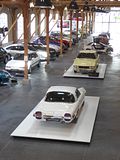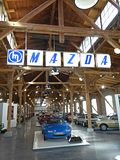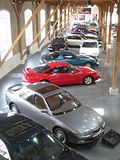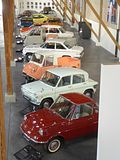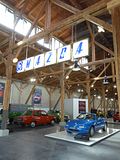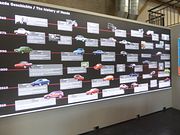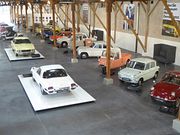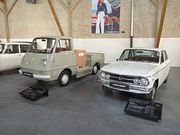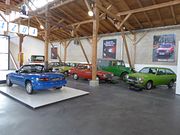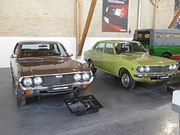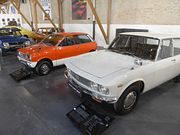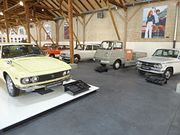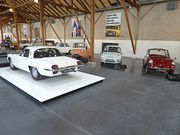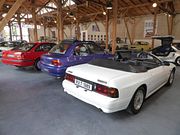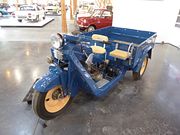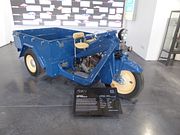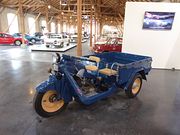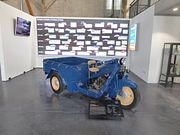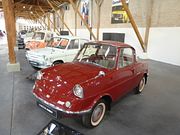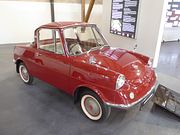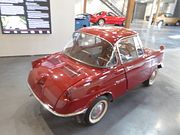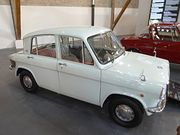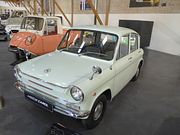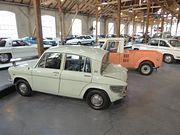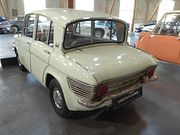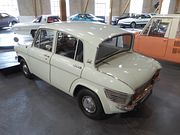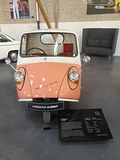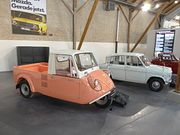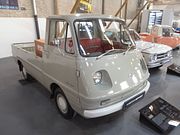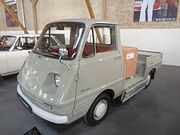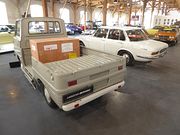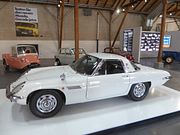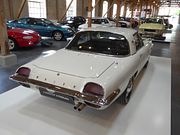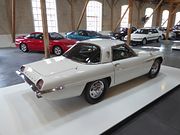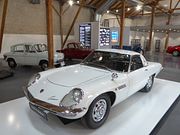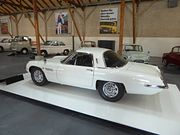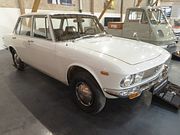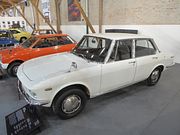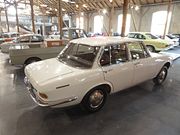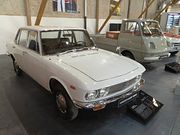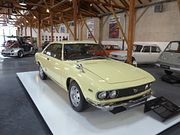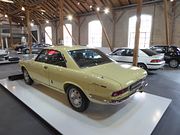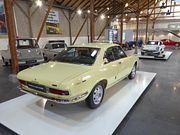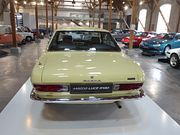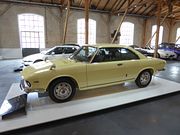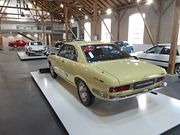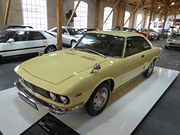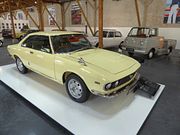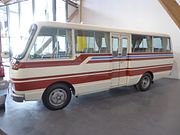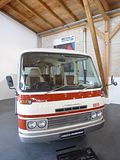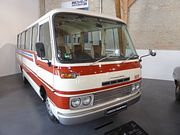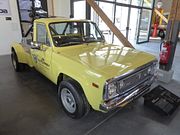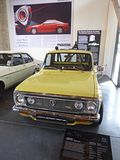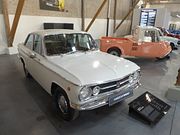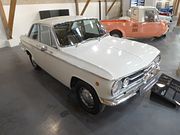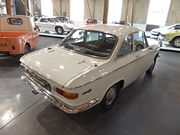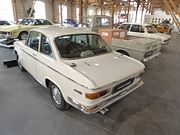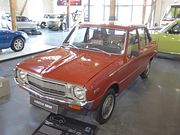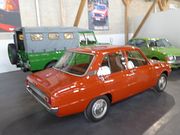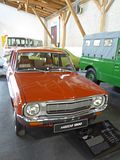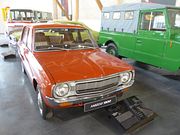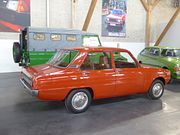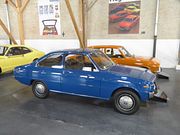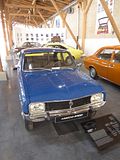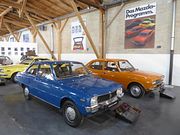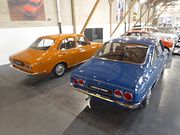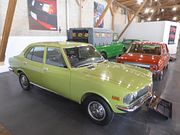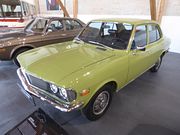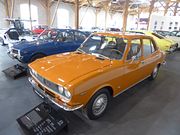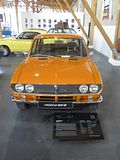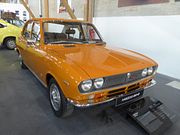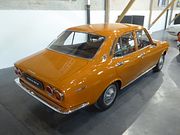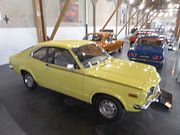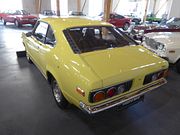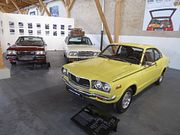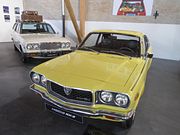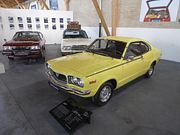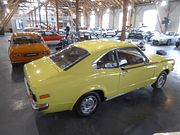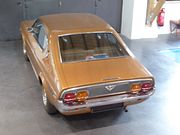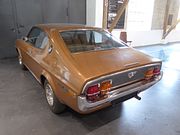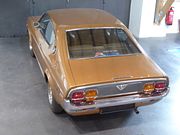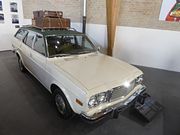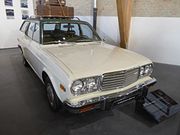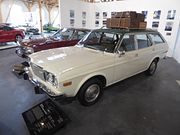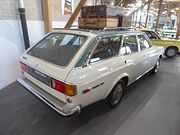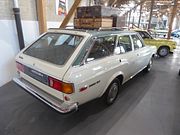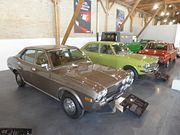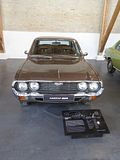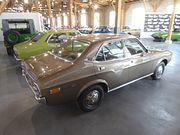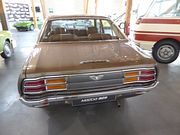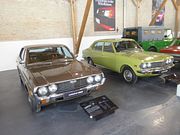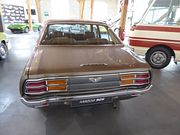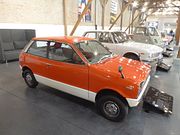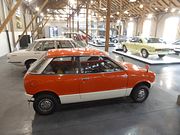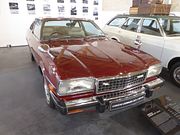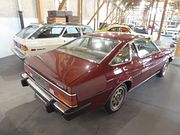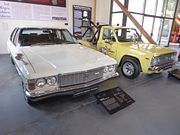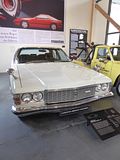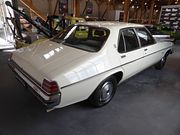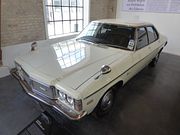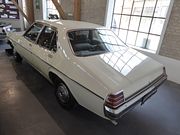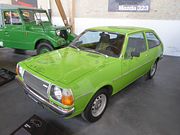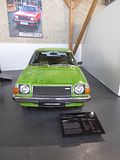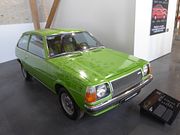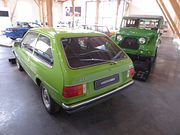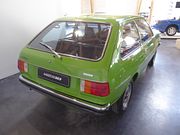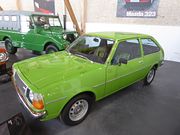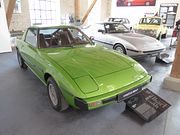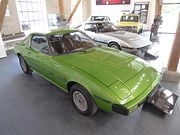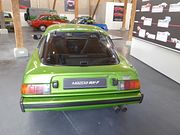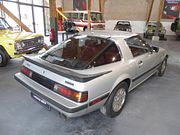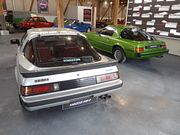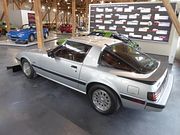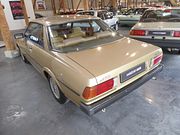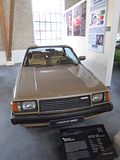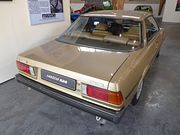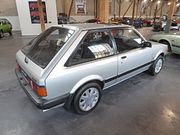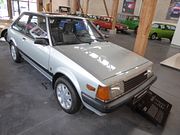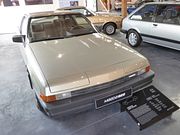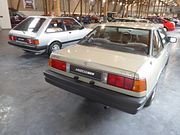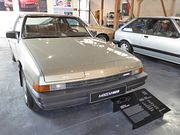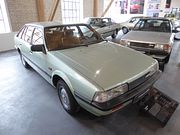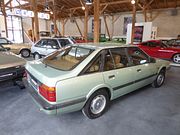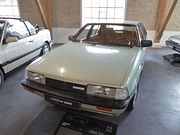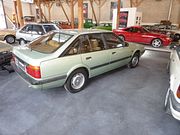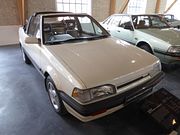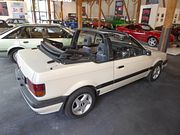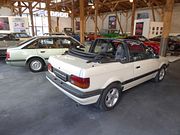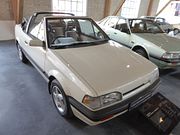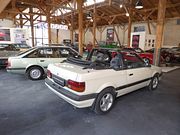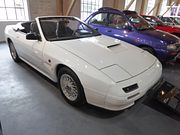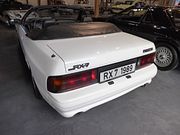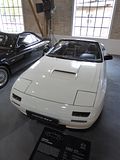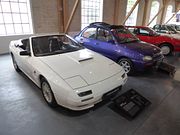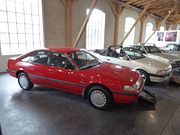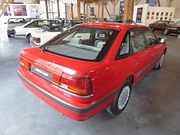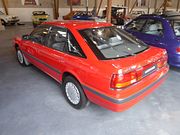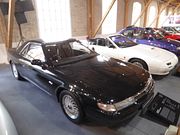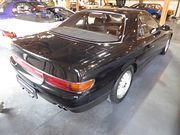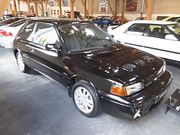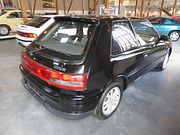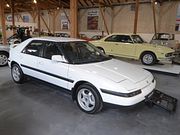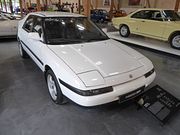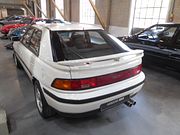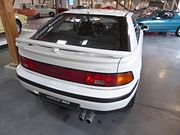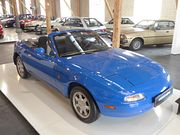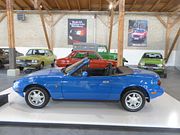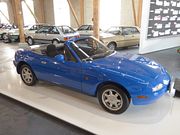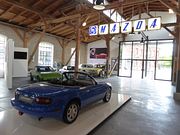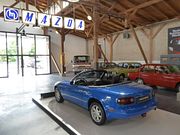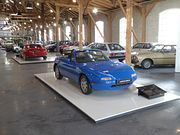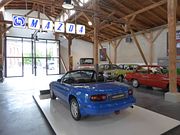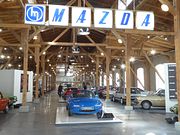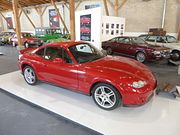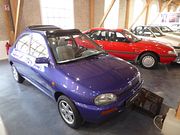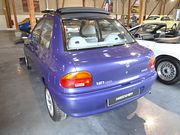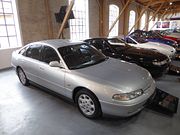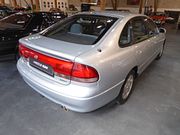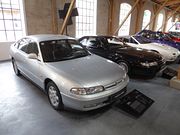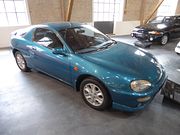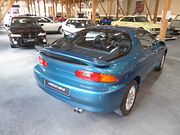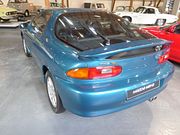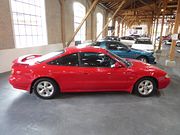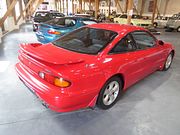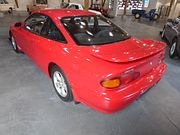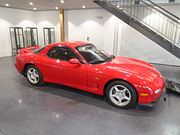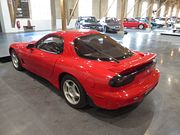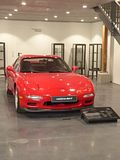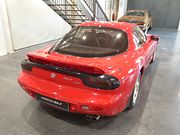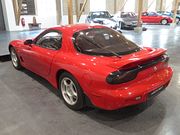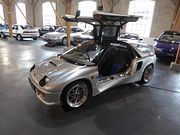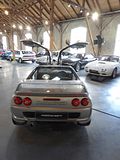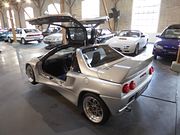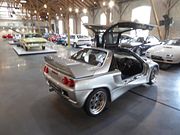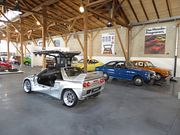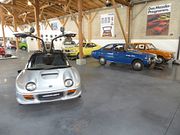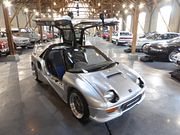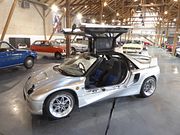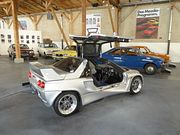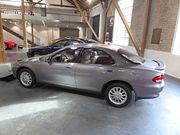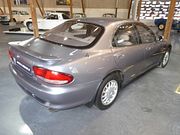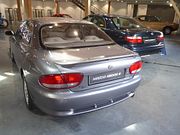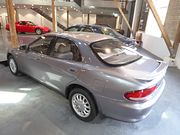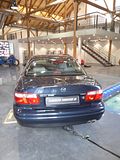More often than not, the news about motor museums in recent times has been of yet another one deciding or being forced to shut its doors for the last time. Rising costs and falling attendances and hence income sources are most often the cause behind lots of the smaller and in many cases long established museums around the world finding that they are just no longer viable. So it was a pleasant surprise to learn of the opening of a new car museum, and even better to learn that the contents would be something largely unlike any other in Europe. This is a museum dedicated to Mazda cars, and is the first such outside the brand’s native Japan. The new museum is in the attractive German city of Augsburg, around an hour north of Munich, and this new venture is housed in a collection of restored buildings that were once an old tramway depot. The museum houses a subset of the collection of cars amassed over many years by Emil Frey, a local dealer who has been selling Mazda cars in Germany since 1978, only a few years after the 1972 start of sales in the country. In 1971, Walter Frey founded Auto Frey in Gersthofen near Augsburg, and it remains a family firm to this day. The decision to go with this Japanese car maker did not come by chance. The rotary engine, Mazda’s long-time signature feature, fascinated Walter Frey and his passion for technology. Walter Frey has been an avid car collector for more than 30 years. It all started when he discovered and bought his first Mazda Cosmo Sport in New Jersey in 1980. This car now stands as the proud centrepiece of all the vehicles on show. Frey passed his passion down to his sons, and together they have created the largest collection of Mazda production vehicles the world has ever seen. The collection of 120 vehicles represents every model and series launched by the Japanese car manufacturer since the 1930s. Opening a museum was a natural decision. To accomplish their dream of owning a car museum, the Freys needed one thing above all else: a big enough building. With the help of the local mayor, they found it. The old tram depot at Senkelbach had the space they needed plus plenty of historic charm. The building dates from 1897 and it enjoys substantial heritage protection. Lovingly refurbished, this venue has a unique flair and is an ideal setting for the cars. With around 120 historic Mazda cars in the collection, there is not space to display anything like that number, so the Freys have said that the displays will be changed on a frequent basis, though some of the most significant cars, such as that 1967 Cosmo 110S will likely be pretty much a permanent feature of the museum. Even so, it will be worth going back periodically to see what is on show. I was able to visit literally a week after the official opening of the museum, as I happened to have a weekend in Munich already in the diary, and having seen a number of press articles about it and also photos from a friend of mine who lives in Munich and who got there even before I did, it seemed far too interesting not to pay that early visit. I have presented the vehicles in this report more or less in chronological order of product introduction, which is not quite how they were sequenced in the museum, but the layout is such that you can wander freely back and forth as you trace the history of this often innovative Japanese marque.
The company’s history goes back to 1920, and it was making cork substitutes from native plants which the company, the Toyo Cork Kogyo Co. Ltd. specialised in. The company was founded on 30 January 1920 in Hiroshima. There was a high demand for the final product from industry as a sealing material. Over time, the global market came to satisfy this demand with natural cork, causing Toyo Cork Kogyo Co. Ltd. to lose its core business. In response to this, Jujiro Matsuda, who became the President in 1921, shifted the production of “Far-Eastern manufacturing” (Toyo Kogyo) to mechanics. In 1927 the company dropped the word “cork” from its name permanently. In 1930 work started on developing a motorised three-wheel truck. The name Mazda appeared for the first time in 1931; series production began on the first motorised vehicle under the name Mazda GO. Its name originates from Ahura Mazda, the ancient Persian god of light, also the god of wisdom, intelligence and harmony. He is also a symbol for the origins of Eastern and Western cultures. The name also derives from the name of the company’s founder, Matsuda, which is pronounced Mazda in Japanese.
And here is one of those Mazdago, three-wheeled open “trucks” that was first produced in 1931 and which resembled a motorcycle with an open wagon or truck bed. It was steered with handlebars and powered with an air-cooled one-cylinder engine/transmission combination unit. It was sold by Mitsubishi in Japan. It was considered to be the first autorickshaw. Production resumed soon after the war, and the first exports began in 1949, when the model was made available in India. Over the years, it would be produced in different variants and spawned other similar designs such as the Hopestar and Daihatsu Midget. It was replaced in the post-war era by an entire range of three-wheeled Mazda trucks, with around 30 different vehicles in the range by the end of the 1950s. The example seen here dates from 1950.
Although Mazda produced a prototype of their first 4 wheeled car in 1940, the war put an end to any production prospects and it was not until the appearance of the Mazda R360, a kei car, that Mazda produced their first real car, a two-door, four-seat model. Introduced in 1960, it featured a short 69 inch wheelbase and weighed just 838 lb (380 kg). It was powered by a rear-mounted air-cooled 356 cc V-twin engine putting out about 16 hp and 16 lb/ft of torque. The car was capable of about 52 mph.It had a 4-speed manual or two-speed automatic transmission. The suspension, front and rear, was rubber “springs” and torsion bars. Within a few years of introducing the R360, Mazda had captured much of the lightweight (kei car) market in Japan. It was augmented by the Mazda P360 “Carol” 2+2 in 1962, as well as a convertible version in 1964. Production of the R360 lasted for six years.
The Mazda R360 was complemented by the more grown-up 2-door sedan Mazda P360 Carol in February 1962, the company’s first 4-passenger car, and complemented the three-wheeled Mazda Mazdago. It was more substantial than the R360: although its total length of 2,980 mm (117.3 in) was the same, its 1,930 mm (76.0 in) wheelbase was considerably longer. The Carol weighed in at 525 kg (1,157 lb), versus 380 kg (838 lb) for the diminutive R360. It used the DA, a 18 PS, rear-mounted water-cooled 358 cc 4-cylinder OHV engine. This is one of the smallest four-cylinder automobile engines in history, only Honda’s 356 cc DOHC alloy inline-four unit (used in the T360 truck) was smaller. The four-speed gearbox was synchronized only on the top three gears. The Carol was perhaps over-engineered: it had a very strong monocoque body, a four-cylinder four-stroke engine with a five-bearing crankshaft and four-wheel independent suspension by torsion bars, but this led to high production costs, comparably high weight, and its very comfortable ride was offset by cramped accommodation. Nonetheless, the Carol was an incredible success in the marketplace, capturing 67% of the Kei market in its first year. A better equipped DeLuxe version was added in May 1962, along with a changed angle of the rear window to help it stay clean. In September 1963, shortly after a reshaped combustion head and upgrade to 20 PS, a four-door version appeared. In October 1966 a minor facelift took place. The car was lightened somewhat, new bumpers were mounted, and the spare tyre was moved from the front to the engine room, freeing up scarce luggage space. Also, the gearbox was now fully synchronized. The last modification took place in 1969, when in response to stricter safety standards a driver’s side headrest and provisions for seatbelts were fitted. Production continued until August 1970, by which time 265,226 Carol 360s had been built. The Carol 600 appeared in the autumn of 1962 with a larger 586 cc RA OHV engine and longer at 3,200 mm. The extra length was due to more prominent bumpers, passenger space was as restricted as in the 360. Weight ranged from 560 to 585 kg (1,235 to 1,290 lb). It was also available as a four-door sedan, ahead of the lesser Carol 360. The car was called the “600” or “P600” in export markets. At home, there was a Standard two-door, and DeLuxe two- or four-door versions. Production ended in November 1964, after the introduction of the more spacious Mazda Familia 800 sedan version. Around 8,800 Carol 600s were built. Mazda did not offer a Kei class passenger car for two years, until the 1972 introduction of the Chantez.
The Mazda K360 was a three-wheeled light truck, which first went on sale in 1959 in Japan. It was the replacement for the Mazda Mazdago. The vehicle is 2.975 metres in length, 1.28 metres wide, 1.43 metres tall, weighs 485 kilograms, and has a top speed of 65 km/h. Production ended in 1969. In total, 280,000 vehicles were produced.
Mazda first introduced its small van, the Bongo, in May 1966. It featured a rear-mounted 782 cc water-cooled OHV SA 4-stroke engine driving the rear wheels. The rear-engined Bongo was produced in two versions from 1968, as the F800 was joined by the bigger-engined F1000. This has a 987 cc PB overhead valve inline-four engine with 48 PS at 5500 rpm. The chassis code for the 1-litre model is FPA. Mazda also showed an electrically powered version of the van, which could reach 75 km/h (47 mph) and with a 60 km (37 mi) range. This remained a prototype. The engines were shared with Mazda’s Familia small car range. Production ended in 1975, due to Mazda suffering serious economic troubles and upcoming stricter emissions regulations for 1976. This model retained the same body shape for its 10-year production life, the later models fitted with inertia-reel seat belts, and separate front parking indicator lights. The rear-engined Bongos had a full chassis (using the same Mazda 1000 engine as other variants mounted to a four-speed transaxle at the rear) and were very strong and due to the low gearing, able to carry half a ton. Due to rust and poor maintenance, these Bongos are now rare. The 1000 pickup and Bongo chassis are different, with common front suspension and brake components.
The Mazda Cosmo is a grand touring coupé that was produced by Mazda from 1967 to 1995. Throughout its history, the Cosmo served as a “halo” vehicle for Mazda, with the first Cosmo successfully launching the Mazda Wankel engine. The final generation of Cosmo served as Mazda’s flagship vehicle in Japan, being sold as the Eunos Cosmo through its luxury Eunos division in Japan. Mazda chose to use the name “cosmo”, reflecting international cultural fascination with the Space Race, as Mazda wanted to showcase the rotary engine as forward-thinking, with a focus on future developments and technology. The first Mazda to bear the Cosmo name (called the 110S on models intended for export) was, along with the NSU Ro80, one of the first production cars to feature a 2-rotor Wankel engine. A prototype was presented at the 1964 Tokyo Motor Show, one month before the 1964 Summer Olympics, and after the introduction of the NSU Spider at the Frankfurt Motor Show; 80 pre-production Cosmos were produced for the Mazda test department and for dealership testing between 1965 and 1966. Full production began in May 1967 and lasted through 1972, though Cosmos were built by hand at a rate of only about one per day, for a total of 1,176 (343 Series I cars and 833 Series II cars). The Series I/L10A Cosmo was powered by a 0810 two-rotor engine with 982 cc of displacement and produced about 110 hp (thus the 110 name). It used a Hitachi four-barrel carburettor and an odd ignition design—two spark plugs per chamber with dual distributors. A four-speed manual transmission and 14-inch wheels were standard. In Japan, the installation of a rotary engine gave Japanese buyers a financial advantage when it came time to pay the annual road tax in that they bought a car that was more powerful than a traditional inline engine, but without having the penalty for having an engine in the higher above-one-litre tax bracket. The front suspension was a coil-sprung double-wishbone design with an anti-roll bar. The rear used a leaf-sprung de Dion tube. Unassisted 10 inch disc brakes were found in front with 7.9 inches (201 mm) drum brakes in the rear. Performance in the quarter-mile was 16.4 seconds, with a 115 mph (185 km/h) top speed. The price was lower than the Toyota 2000GT at 1.48 million yen (US$4,100). The Series II/L10B was introduced in July 1968. It had a more-powerful 128 hp and 103 lb·ft (140 N·m) 0813 engine, power brakes, 15 inch wheels and a 5-speed manual transmission. The wheelbase had been expanded by 15 inches (38.1 cm) for more room and a better ride. This Cosmo was good for over 120 mph (193 km/h) and could accelerate to cover a quarter-mile in 15.8 seconds. Visual changes included a larger grille under the front bumper with two additional vents to each side of this “mouth”. Only 833 were ever made, and fewer than six Series II models were initially imported into the United States. The price was up a bit to 1.48 million yen (US$4,390). Comedian and former talk show host Jay Leno owns a 1970 Series II Cosmo which and indeed I saw him and this car at the Japanese Classic Car Show at Long Beach in September 2007. These cars come up rarely for sale and when they do, the prices are not cheap.
Following an agreement signed with Bertone in April 1962, the 1965 Luce 1500 show car was designed by Giorgetto Giugiaro of Italy. It was low and sharp, looking more like a contemporary BMW Bavaria than its smaller Mazda companion models, the Familia and the kei car Carol. The production version (SUA), started production in July 1966 and launched in August, had a higher roofline but retained the BMW-esque look. It was a front-engine, rear-wheel-drive four-door sedan, and featured a square 1490 cc 1500 SOHC engine, producing 78 PS at 5500 rpm and 84.5 lb/ft. It sold poorly at ¥695,000. The 1500 SS version with twin carburettors was introduced in June 1967, producing 86 PS at 5500 rpm and 86.9 lb/ft at 5500 rpm. A stroked 1.8-litre (1796 cc) 1800 engine was added in December 1968. This new model, the Luce 1800, produced 104 PS at 5500 rpm and 112 lb/ft at 2500 rpm. To accommodate the taller 1800 engine the bonnet on this model has a slight bump in the middle with an air inlet on the leading edge. An estate was also added in April 1967, with the same engine as the sedan (SUAV). Unlike most commercial vehicles at the time, it was also available with a three-speed automatic transmission. The Luce Mark I was sold in most export markets under the names “Mazda 1500” and “Mazda 1800”, and this was the first Mazda model sold in the UK. The car remained in production until March 1973.
A rotary-powered Luce appeared in 1969, the Luce R130 and it was produced from October 1969 to 1972. It used a 1.3-litre 13A engine, which produced 126 hp and 127 lb/ft. Quarter-mile performance was 16.9 seconds. This model was styled by Giorgetto Giugiaro, then working for Bertone, as a front-wheel-drive two-door coupé with front disc brakes, which was similar to the NSU Ro 80. This model, Mazda’s only front-wheel-drive rotary, is now a collector’s item and very rare. Fewer than 1,000 were built.
Three of the most unusual exhibits were these: the XV-1 Pathfinder, Parkway Bus and a Rotary Pickup Truck. Of these, the XV-1 Pathfinder is undoubtedly the quirkiest. The XV-1 Pathfinder was designed by Mazda in Hiroshima in the late 1960s, and then shipped to Burma in the form of knock-down kits. Those knock down kits got put together at the “Ministry of Industry’s No. 2 Automobile Factory” in Htonbo,. It is certain that Mazda built these Pathfinder XV-1s from 1970 to 1973, though there is a belief that they may have remained in production until the 1990s. The SUVs were used mostly by military, police and government officials, came as either soft-tops or hard-tops, and could seat up to nine people thanks to a pair of giant folding benches in the rear. They had in-line 4 cylinder engines and a 3 speed manual box, though it is understood that a diesel model was also offered. Underneath, there’s a two-speed transfer case (with a big skid plate underneath it), a thick steel frame, a fuel tank, an exhaust pipe, and a pair of driveshafts—just standard old-truck stuff. It is the styling which is what makes this thing all the more intriguing. Apart from a couple that have found their way to Japan, it is understood that the only place in the world where you will find these (and there are still quite a lot left) is in Myanmar (Burma).
The Mazda Parkway is a minibus that was based on the Mazda Titan platform, and was exclusive to Japan. In 1974, the Parkway was installed with the 13B rotary engine and was also available with turbo engine options; displacements were at 2.5 and 2.7. The rotary-powered minibus was called the Parkway Rotary 26, and could accommodate 26 passengers. It was introduced July 22, 1974 and ceased production in 1977.
The Rotary Pickup (REPU) was the world’s first and only Wankel-engined pickup truck. It was sold from 1974 to 1977 and appears to only have been available in the US and Canada. The Rotary-Engined Pickup (REPU) had a four-port 1.3-litre 13B four-barrel carburettor engine, flared wings, a battery mounted under the bed, a different dash, a front grille, and round taillights. It is estimated that just over 15,000 units were built. Most were made for the 1974 model year (PA136 chassis), but the effect of the energy crisis on sales caused Mazda to restamp many of the 1974 models with a prefix “S”, designating them as 1975 models; (SPA136). Approximately 700 units were built for the 1976 model year, when the four-speed manual transmission was upgraded to a five-speed. Mazda invested in a moderate redesign for the 1977 model (PA236), updating its electrical systems and adding 4 inches (100 mm) cab stretch for increased comfort. About 3,000 units were manufactured, after which the REPU was discontinued due to poor sales. Road & Track magazine was impressed with its “smooth, quiet power” and “nice” interior. The vehicle retailed for about US$3,500; its observed fuel economy was 16.5 mpg US. Most of the trucks are found on the west coast of the US; they continue to be sought out by enthusiasts. Like many Mazda rotary vehicles, the REPU was raced. It took third place in the 1976 SCCA Mojave 24 Hour Rally driven by Malcolm Smith and Jack Sreenan.
A second generation Familia appeared in November 1967 with the same pushrod 987 cc engine as used in the previous generation sedans. It was sold as the “Mazda 1000” in some markets. After an April 1970 facelift, the slightly different OHC “PC” engine was also offered, in a model called the “Familia Presto” in the domestic Japanese market. A larger 1169 cc inline-four engined version came along in February of the following year, becoming the “Mazda 1200” for export. In this form, the car was first exhibited in Europe at the 1968 Paris Motor Show in the autumn of that year Power outputs (SAE gross) in Japan of the facelifted, overhead-cam-engined versions were 62 and 75 PS respectively. The Van (wagon) model was available with either three or five doors, although most export markets only received the five-door version. From model year 1970 on the Familia was also available with the new overhead camshaft 1.3-litre TC engine, derived from the smaller 1.0-litre OHC engine already seen in the first generation Familia coupé. 1970 also saw a larger sedan which shared much of its mechanicals with the Mazda Capella. The Familia was exported as the “Mazda 1300”, and replaced the previous generation 1200 model in most markets.
The sedan and coupé were updated in the autumn of 1973, but the truck and wagon/van versions continued with little change. The vans and pickup trucks actually soldiered on until 1978, by which time a wagon version of the succeeding FA4 Familia (323/GLC) had been introduced. The later pickup versions were also available in a long-wheelbase version, and still featured an 85 PS version of the 1.3-litre TC engine, unaffected by the tighter Japanese emissions standards for passenger cars. The pickup models were built until 1991 for markets such as South Africa, Zimbabwe, and the Philippines. In South Africa, the little bakkie was sold as the “Mazda F-1000” or “F-1300”. The cars seen here were a 1000 and the later 1300 from 1974.
In 1968 Mazda added a Familia Rotary model to the range, offered in both two-door coupé and four-door sedan variants. Sedan models were given an additional “SS” nameplate. The Familia Rotary was powered by a 982 cc 10A rotary engine and the coupé version was sold outside Japan as the “Mazda R100“. After an April 1970 update (known colloquially in Australia as the Series 2) it was known as the “Familia Presto Rotary” in Japan as the Presto nameplate was added into the entire Familia range. Power was rated at just 100 hp due to a small carburettor (thus the “R100” name). The rotary engined R100 has a unique front end design, with a more prominent pointed hood, grille, and bumper. The rear also gained its own design with twin round tail lights, which became for a time a signature design element for the rotary engined versions of Mazda’s cars. Inside, the cars were more sumptuously appointed with plusher seats and chrome plated accents, full sized interior door trim panels, a floor mounted handbrake lever, and a unique cockpit styled dashboard with full instrumentation. Mazda referred to this dashboard as the “T-Dash”, and fitted it to top spec piston engined variants of the Familia on the Japanese market as well as the rotary models. In Japan, the installation of a rotary engine gave Japanese buyers a financial advantage when it came time to pay the annual road tax in that they bought a car that was more powerful than a traditional inline engine, but without having the penalty for having an engine in the higher 1.0-litre tax bracket. This was the only generation of the Familia that had the rotary engine offered. When Mazda updated the rotary engine to single distributor design in late 1973 with a raft of improvements to improve reliability and fuel economy, the smaller 10A engine was discontinued. Upgrading the Familia Rotary to the 12A engine would have cost the car its tax advantage in Japan, and the decision to discontinue it was made, despite the Familia body continuing production for some years to follow.
The first Capella was introduced in May 1970 and lasted until 1978, and was introduced as an intermediate alternative to the smaller Mazda Familia and the larger Mazda Luce. It was powered by four-cylinder SOHC valve engines displacing either 1.5 or 1.6 litres. Output is 92 or 100 PS, respectively; and 144 N⋅m (106 lb⋅ft) of torque for the larger displacement version. The first models all had rectangular headlights, while the rotary-engined models received round twin headlamps beginning in October 1971. From 1972 all models received the double headlamps. The taillight design was changed repeatedly over the production run. This generation was sold in export markets as the Mazda 616 in sedan and, for some markets, coupé configurations. There was also a Mazda 618 briefly sold in the United States. The Mazda 616 was a major component of Mazda’s United States expansion in 1971, having been preceded by its rotary brother, the RX-2, the previous year. It featured the 1.6-litre (1586 cc) engine, which was later used in the 808. The American Capella was updated and renamed the next year: the 1972 Mazda 618 had a larger 1.8-litre (1796 cc) VB engine which was only used in the US and not related to the similarly-sized “VC” used in the rest of the world. Lasting just one year, the 618 nameplate was not used again in the United States and the only federalized version of the Capella for 1973 was the RX-2. The 616 was replaced in 1978 by the 626/Capella.
An optional Mazda Wankel engine was offered and known as the Capella Rotary in Japan or the Mazda RX-2 for export. In addition to the 1.6, a Capella 1500 was added in October 1970. The Capella received a fairly thorough facelift in February 1974. This facelift included a restyled front end (lengthened by 110 mm) and a redesigned dashboard. This model received an optional 1769 cc engine for some markets and in Japan it was sold with the “AP” suffix, for “Anti-Pollution”. The 1500 was no longer available. The facelift rotary version received the CB12S chassis code rather than S122A. In Japan, the installation of a rotary engine gave Japanese buyers a financial advantage when it came time to pay the annual road tax in that they bought a car that was more powerful than a traditional inline engine, but without having the penalty for having an engine in the higher 1.5-litre tax bracket. This was the only generation that had the rotary engine offered. The RX-2 was assembled under contract in New Zealand from 1972 for Mazda New Zealand by Motor Industries International in Otahuhu, South Auckland. It was the first and only rotary-engined car ever to be assembled in the country and was made as both a sedan, with manual or automatic transmission and a manual-only coupé. The 616 was also built but was much less popular. In South Africa, where the Capella was assembled first by Illings and then by Sigma, it was available with the 1600 or 1800 reciprocal engines as well as the rotary. The rotary claimed 130 hp SAE in South Africa. The facelift version arrived two years late there, in mid-1976. At the end of that year, the Capella RS was introduced—this lowered version with Rostyle wheels was limited to 20 cars per month. South African production of the Capella Rotary continued into 1979, since Sigma had taken the decision not to build the second-generation Capella there but to focus on the Colt Galant instead.
The name Mazda Savanna (sometimes incorrectly spelled “Savannah”) was used on the rotary-powered model sold in Japan, as a coupe, sedan, and wagon. Internationally it was called the Mazda RX-3. It was smaller and sportier than its brother, the Capella Rotary/RX-2, and was largely identical to its conventional inline-four donor model, the Mazda Grand Familia. It was available from September 1971 through 1978 in Super Deluxe coupé, Deluxe sedan, and station wagon forms. The Super Deluxe coupé was heavier (884 kg vs 864 kg) and carried an optional body stripe, clock, and the centre console/high armrest and collapsible steering column. It originally used a 10A rotary engine like the Mazda Familia Rotary Coupe/Mazda R100, but US cars shared the larger 12A engine from the RX-2. Performance-wise the 10A RX-3 was not able to match the RX-2 with 12A. With a weight-to-power ratio of 10.9 kg per kW compared to the RX-2’s 9.9 kg per kW, the RX-3 was slower. The 12A RX-3 wasn’t able to match the RX-2 with 12A either, despite its lighter weight. The smaller engined version has the internal model code S102A, while the larger one is known as the S124A. In Japan, the installation of a rotary engine gave Japanese buyers a financial advantage when it came time to pay the annual road tax in that they bought a car that was more powerful than a traditional inline engine, but without having the penalty for having an engine in the higher 1.5 litre tax bracket. The first Mazda Savanna went on sale in September 1971 and remained in production until 1977. It was sold as the Mazda RX-3 internationally when installed with the rotary engine and was otherwise largely identical to the inline-four-equipped Mazda Grand Familia. Externally the Savanna and export RX-3 was differentiated from its piston engines sibling by a nose panel with dual round headlights and a more prominent and pointed honeycomb grille, and round tail lights on the rear of sedans and coupés. An estate version, the RX-3 Sports Wagon, was sold for just one year in the U.S., from 1972 to 1973, when it was replaced by the Luce/RX-4 wagon. However the “Savanna Sports Wagon” remained in production in Japan right through until the end of Savanna production in 1977. Initially in all markets except North America all cars were designated S102A and came with the 982 cc (2×491 cc) 10A. S124A cars introduced later on came with the 1146 cc (2×573 cc) 12A. While the larger S124A eventually replaced the S102A in most markets, the S102A remained on sale alongside the S124A in Japan through to early 1974 with all the Series II updates. The Series I S102A remained on sale in some markets even longer, being available in the United Kingdom until the 1975 model year at least, though this was most likely as a result of stocks of earlier production vehicles remaining unsold due to a combination of both the fuel crisis and the rotary engine’s early reputation for poor reliability. While the Series I Savanna and RX-3 were powered by the 10A in Japan, Australia, and Europe, North American markets got the larger 12A taken from the RX-2 coupled to either a four speed manual or automatic transmission. Along with this engine change came the chassis prefix S124A. The 1972 Savanna / RX-3 Sports Wagon was the world’s first rotary-powered estate. In September 1972 the Savanna GT went on sale exclusively in Japan. This model received the larger 12A motor with 125 hp and was coupled to a five speed transmission. Along with this came slightly lowered suspension, as well as wider 5.5″ rims. It received revised tail lights and a 5 Speed badge on the rear, an RE12 badge on the grille, and a completely redesigned dashboard and console exclusive to the model. It also had unique leather-like vinyl upholstery with GT embossed on the headrests. It came also with the chassis code S124A. The 10A engine output was 105 hp and 100 lb·ft (135 Nm). 0–60 mph acceleration time was 10.8 seconds, and the car ran a 17.6 second quarter-mile (400 m)(16.3 for the RX-2). In 1972 all rotary engines had their die-cast rotor housing coated with a new process: The new Transplant Coating Process (TCP) featured sprayed-on steel which is then coated with chrome, giving greatly increased engine life. In mid 1973, Mazda released a visually updated Savanna in Japan, though drivetrain choices remained the same with the S102A 10A and the S124A 12A both available in twin distributor form. Externally the entire front end sheet metal was revamped and a different set of taillights with twin brake lights were included (commonly known as Savanna tail lights in Australia). In the months that followed, the range was updated to the single distributor 12A and the 10A motor was discontinued in early 1974. The Series II RX-3 came to Australia in March 1974 powered by the new 12A single distributor (12B). The starter motor was relocated in these updated engines from the top of the engine to the lower left hand rear side. Other internal 12A changes included moving from dual row side seals to single row and significant changes to apex seal design. The Series II was slower than the 10A Series I down the quarter mile even with the 1,146 cc 12A’s greater capacity and 15 percent more power. The Rotary Engine Anti Pollution System (REAPS) hurt torque. As a result, the Series 2 was slow off the mark but had a better top speed. The loss of torque plus a 44-kilo weight increase slowed the Series II to a 17.8 second quarter mile. Interior changes were minor and included a change from the km/h/mph speedometer to a 200 km/h speedometer (180 km/h for the 808), an exhaust overhead light, a 50 Amp ammeter (up from 30 Amps) plus design changes to the trims and seat belts. Notably the radio antenna was enhanced by a twin post (rather than single) design. The 1974 model kept the three spoke plastic wood grain steering wheel; the 1975 received a fake leather wheel with slots cut into its three spokes. The new 12A single distributor engine output was 130 hp and 115 lb·ft (156 Nm). 0–60 mph time was 10.8 seconds, and the car ran a 17.7 second quarter-mile (400 m). The Japanese market Savanna was updated visually in June 1973, though drive lines weren’t updated until later in the year. Mazda put the new 12A “AP” single-distributor engine in the RX-3 in late 1973. It was refreshed again in 1975 with a “REAPS-5” engine. In 1976 the Series III Savanna / RX-3 was released in Japan and the U.S., but exports to Australia and New Zealand ceased. The nose cone wore a new lower spoiler-type lip, and the rotor shaped badge was replaced with a new Mazda corporate font badge on the grille, offset to the left of centre. Overall these and other detail changes made the cars much plainer, and certainly lost the model some of its charm. Savanna and RX-3 production was phased out in 1978 to make room for the new Mazda RX-7. Of all the pre-RX-7 rotary vehicles Mazda built (930,000 in total), the RX-3 was by far the most popular. Of all the RX-3’s built, the coupe exceeded 50 percent of total sale – all facts which influenced the design profile of the RX-7.
Mazda released a second generation LA2 series Luce in November 1972—a rotary powered model that would be later exported as the Mazda RX-4. The conventionally-engined Luce sedan (LA2VS) would not arrive to the Japanese market until April 1973, after starting production in March. It was available as a hardtop (coupé), “formal sedan”, “custom sedan”, and as a station wagon which was also sold as a van in the domestic Japanese market. The original hardtop coupé received a longer, more aggressive front design, which was also installed on the custom sedan. The formal sedan and the van/wagon received a somewhat shorter front end which was also used on the export versions (929). For the facelifted LA3 model from 1976, only one front design was used—one with a more square design. In most export markets, the Japanese Luce Rotary sold as the Mazda RX-4. It was a larger car than its rotary-powered contemporaries, the Capella-based RX-2 and Grand Familia-based RX-3. It used the Luce chassis, replacing the R130 in October 1972, and was produced through October 1977. Its predecessor (the R130) and replacement (the rotary Luce Legato) were not sold in the United States. Mazda marketed the RX-4 as being sporty and luxurious “personal luxury car” with the RX-4 having the best of both worlds. This gave Mazda a well needed boost in the popularity of the Wankel engine unique to Mazda. In Japan, the rotary-engined variants offered an advantage with regards to the annual road tax bill in that Japanese drivers paid less than the in-line engine equivalents, while receiving more performance from the rotary engine. The RX-4 was initially available as a hardtop coupé and sedan, with a station wagon launched in 1973 to replace the Savanna Wagon. Under the bonnet at first was a 130 or 120 PS 12A engine, with the higher-powered version reserved for the five-speed GR-II and GS-II models. The extra power was due to a different exhaust and adjusted ignition timing. The emissions scrubbed “AP” models had five horsepower less, although after June 1973 they received the same power as the regular versions. This was complemented and then replaced by the larger 13B in December 1973 producing 135 PS. This model has 125 PS, for export. This engine was Mazda’s new “AP” (for “anti-pollution”) version, with much-improved emissions and fuel economy, but somewhat worse cold-starting behaviour. In South Africa it was produced until 1979, all years only with the AP engine. The car used an strut-type independent suspension in front with a live axle in the rear. Brakes were discs in front and drums in the rear. Curb weight was low at 1,188 kg (2,620 lb) and the wheelbase fairly short at 2,515 mm (99 in). The body was freshened in 1976.
The first Mazda 929 was introduced in 1973, as an export name for the piston-engined second generation Mazda Luce. The first generation Luce had been called the “Mazda 1500” or “Mazda 1800” in export markets, but as engines of different displacement were beginning to be used across lines, such a naming philosophy would have soon become confusing. The 929/Luce was a large (for Japan) coupé, sedan, and station wagon powered by a 1769 cc Mazda VB engine. Output was 94 PS and 137 N⋅m (101 lb⋅ft). The Luce/929 was updated in 1975 with an optional 1970 cc engine which produced 103 PS and 167 N⋅m (123 lb⋅ft) from a two-barrel carburettor. Production continued until 1979.
The Mazda Chantez (chassis code KMAA) is a two-door kei car that was introduced by Mazda in July 1972. The Chantez had a longer wheelbase at 2,200 mm (86.6 in) than most of its competitors and featured the powerful two-stroke “AA” engine also seen in the Porter. With 35 bhp, top speed was 115 km/h (71 mph) and the 400 m (0.2 mi) sprint was dispatched in a sprightly 20.6 seconds. In more recent testing of a 1972 GF II, 0–100 km/h came up in 35.8 seconds. The engine was installed longitudinally powering the rear wheels, and the spare tire was installed next to the engine on the right side. The name “chantez” is the second-person plural present indicative of chanter, which in French means “to sing”. Equipment levels ranged from the lowest spec L (less chrome, body coloured bumpers and B-pillars), via the LX, GL, GF, and GL II to the top of the line GF II, which featured a sports interior, radial tyres, and available two-tone paint. In late 1974, anticipating a changing law at the turn of the year, the boot lid and front bumper were modified to fit larger-size license plates. Originally, the Chantez had been planned to use a single-rotor Wankel engine, but the other Kei manufacturers considered this unfair and blocked Mazda’s plans. As a result of not being able to build the car they had originally planned, Mazda lost interest in the Kei class and sales halted without a replacement in 1976, on the eve of new Kei car regulations. Mazda did not market another Kei passenger car until 1989 with a reintroduction of the Carol, which was a rebadged Suzuki Alto, and to this day still choose not to make their own engines for the Kei class.
The second generation CD Cosmo appeared in 1975 and lasted until 1981. It was known as the Cosmo AP (Anti-Pollution) in Japan, and sold internationally as the Mazda RX-5, though in some export markets its piston-powered counterpart was called the Mazda 121 (a name later applied to Mazda’s subcompact model). Mazda America used the Mazda Cosmo name and offered it from 1976 through 1978, after which the Cosmo was replaced by the Mazda RX-7 as their rotary-powered sports coupe. The CD Cosmo/RX-5 series was positioned as a personal luxury car, offered as a notchback coupe, called the Landau, which included an “opera window” and padded vinyl roof covering, that appeared to be influenced by the 1970s era Lincoln Continental. It was also available as a fastback, but neither body style found many international buyers. It was however an enormous success in Japan where over 55,000 were sold in the first year alone. This new body style competed with the Toyota Crown, Nissan Cedric, Nissan Gloria, and the Mitsubishi Galant Lambda coupes newly introduced to Japan. Due to its poor sales as an export the Series II version, built from 1979, was not exported and remained a Japanese domestic sale only. RX-4 exported to Europe saw very little competition in the rotary-engine equipped market, with the introduction of the short-lived Citroën GS Birotor, as well as any remaining NSU RO80 sedans. The Cosmo was Mazda’s largest rotary-powered coupe, based on the LA series Mazda Luce floor pan and mechanics, but slightly heavier due to body design and more luxurious appointments, including a five-link rear suspension and rear disc brakes. It was available with the 12A and 13B engines. This series Cosmo was joined by the short-lived Mazda Roadpacer, a large, heavy sedan powered only by a rotary engine. A piston engine version, the Cosmo 1800, used a 1769 cc (80 x 88 mm) inline-four SOHC engine that produces 100 PS and 110 lb⋅ft (149 N⋅m). There was also the bigger Cosmo 2000 with 110 PS. The rotary engine had financial advantages to Japanese consumers in that the engine displacement remained below 1.5 litres, a significant determination when paying the Japanese annual road tax which kept the obligation affordable to most buyers, while having more power than the traditional inline engines.
The Mazda Roadpacer AP (Anti-Pollution) is a full-size sedan that was sold by Mazda in Japan between 1975 and 1977, although the last car was not sold until 1979. It was based on the Australian Holden HJ and HX series Premier. Premiers were shipped to Japan without engines, and Mazda fitted a 1.3-litre 13B Wankel engine into the bay. The engine produced 130 hp but just 102 lb⋅ft (138 N⋅m) of torque, meaning the Roadpacer performed rather poorly as it weighed 1,575 kg (3,472 lb). The Roadpacer was introduced to compete with large Japanese flagship sedans Toyota Century, Nissan President, Isuzu Statesman de Ville, and the Mitsubishi Debonair. The 13B produced less power than the Red series motors that powered the equivalent Holdens, and significantly less torque, meaning performance was restrained with a 166 km/h (103 mph) top speed, poor acceleration and terrible fuel consumption. Contemporary reports suggest 9 mpg. The vehicle was not in compliance with Japanese regulations concerning engine displacement and exterior dimensions, and was classed in the mid-size car segment, while the engine displacement placed it in the lower annual road tax brackets. If the car was recognised as being for business use as an executive company car, the road tax bill was very minimal. While the Holden HJ Premier itself was well equipped, Mazda decided to add more. Gadgets of note include a central locking system that activated when the car hit 10 km/h, a chime system that activated at 90 km/h (56 mph), a dictation system and a stereo able to be controlled from both front and back seats. The price was also considered high at 3.8 million yen (US$10,000) in 1975. This was about twice the price of a contemporary Mazda Cosmo or Mazda Luce. Originally intended as transport for high-ranking government officials, the car was sold in the wake of the first fuel crisis and was not a commercial success. Production ceased in 1977 with only 800 units sold.
The Familia AP, known as the 323 in most of the world and GLC for “Great Little Car” in North America, debuted in January 1977 as a rear-wheel-drive subcompact, replacing both the Grand Familia (818) and the preceding Familia (1000/1300). There was a choice of hatchbacks and station wagon bodies, both available with a three- or five-door bodystyle. The estate version came a bit later, first being introduced in June 1978, which also meant that the commercial versions based on the 1970 Familia could finally be retired. Three Mazda engines were available, the 985 cc PC, 1,272 cc TC, and the 1415 cc UC (introduced in March 1978). The 1.0-litre unit was only made for export markets. The new Familia shared many parts with the older Mazda Grand Familia. This was the first appearance of the 323 name, for export markets only. In June 1979 the 323/Familia underwent a facelift, replacing the previous round headlights with rectangular units which were designed as a single unit along with the grille. The new style was in line with that of the recently released Mazda Capella/626 (CB). Other minor differences occurred along with the facelift. A sportier SP version arrived in late 1978. The range was replaced in 1980, however the station wagon models continued in production until 1986. In 1981 a facelift was given to the wagon range, to give a front end treatment similar to Mazda’s front-wheel drive 323/Familia range. A five-speed manual gearbox was introduced later as an alternative to the original four-speed manual gearbox. At the same time the original 7-inch (178 mm) round sealed beam headlights were replaced with square sealed beam units on all models except the van, together with a general styling and mechanical upgrade. A three-speed automatic gearbox was also available on the bigger engined models, it was first introduced (on the 1400) at the end of June 1978. When the next generation front-wheel-drive Familia/323/GLC models were released in 1980, the wagon and van models continued unchanged, due to Mazda not developing wagon models for the newer range. A facelift however was given to the wagons in 1981, which gave the models the front clip (albeit with different bumpers) of the front-wheel-drive models. Production of the wagons continued to 1986, when a new front-wheel-drive model was introduced. Originally available with the 1.3- TC and 1.4-litre UC engines, in export markets the larger unit was replaced with the new 1.5-litre E5 engine for the 1983 model year. This car proved particularly popular in Germany, with very strong sales indeed, helping to establish the brand in the market.
There were examples of all three generations of the RX7 here. This is the first, and during its production life, there were three distinct series. Series 1 (1978–1980) is commonly referred to as the “SA22C” from the first alphanumerics of the vehicle identification number. In Japan it was introduced in March 1978, replacing the Savanna RX-3, and joined Mazda’s only other remaining rotary engine powered products, the Cosmo, a two-door luxury coupe, and the Luce luxury sedan. The lead designer at Mazda was Matasaburo Maeda, whose son, Ikuo, would go on to design the Mazda2 and Mazda RX-8. The transition of the Savanna to a sports car appearance reflected products from other Japanese manufacturers. The advantage the RX-7 had was its minimal size and weight, and the compact rotary engine installed behind the front axle, which helped balance the front to rear weight distribution, and provide a low center of gravity. In Japan, sales were enhanced by the fact that the RX-7 complied with Japanese Government dimension regulations, and Japanese buyers were not liable for yearly taxes for driving a larger car. The rotary engine had financial advantages to Japanese consumers in that the engine displacement remained below 1.5 litres, a significant determination when paying the Japanese annual road tax which kept the obligation affordable to most buyers, while having more power than the traditional inline engines. The Series 2 (1981–1983) had integrated plastic-covered bumpers, wide black rubber body side mouldings, wraparound taillights and updated engine control components. While marginally longer overall, the new model was 135 lb (61 kg) lighter in federalised trim. The four-speed manual option was dropped for 1981 as well, while the gas tank grew larger and the dashboard was redesigned, including a shorter gear stick mounted closer to the driver. In 1983, the 130 mph speedometer returned for the RX-7. The GSL package provided optional four-wheel disc brakes, front ventilated (Australian model) and clutch-type rear limited slip differential (LSD).
Known as the “FB” in North America after the US Department of Transportation mandated 17 digit Vehicle Identification Number changeover. For various other markets worldwide, the 1981–1985 RX-7 retained the ‘SA22C’ VIN prefix. In the UK, the 1978–1980 series 1 cars carried the SA code on the vehicle VIN but all later cars (1981–1983 series 2 & 1984–1985 series 3) carried the FB code and these first generation RX-7’s are known as the “FB”. The licence-plate surround looks much like Buhrer’s “Styling Impressions.” In Europe, the FB was mainly noticed for having received a power increase from the 105 PS of the SA22; the 1981 RX-7 now had 115 PS on tap. European market cars also received four-wheel disc brakes as standard. The Series 3 (1984–1985) featured an updated lower front fascia. North American models received a different instrument cluster. GSL package was continued into this series, but Mazda introduced the GSL-SE sub-model. The GSL-SE had a fuel injected 1.3 L 13B RE-EGI engine producing 135 hp and 180 N⋅m (133 lb⋅ft). GSL-SEs had much the same options as the GSL (clutch-type rear LSD and rear disc brakes), but the brake rotors were larger, allowing Mazda to use the more common lug nuts (versus bolts), and a new bolt pattern of 4×114.3 (4×4.5″). Also, they had upgraded suspension with stiffer springs and shocks. The external oil cooler was reintroduced, after being dropped in the 1983 model-year for the controversial “beehive” water-oil heat exchanger. The handling and acceleration of the car were noted to be of a high calibre for its day. This generation RX-7 had “live axle” 4-link rear suspension with Watt’s linkage, a 50/50 weight ratio, and weighed under 2,500 lb (1,100 kg). It was the lightest generation of RX-7 ever produced. 12A-powered models accelerated from 0–60 mph in 9.2 s, and turned 0.779 g (7.64 m/s²) laterally on a skidpad. The 12A engine produced 100 hp at 6,000 rpm, allowing the car to reach speeds of over 120 mph (190 km/h). Because of the smoothness inherent in the Wankel rotary engine, little vibration or harshness was experienced at high engine speeds, so a buzzer was fitted to the tachometer to warn the driver when the 7,000 rpm redline was approaching. Options and models varied from country to country. The gauge layout and interior styling in the Series 3 was only changed for North American versions. Additionally, North America was the only market to have offered the first generation RX-7 with the fuel-injected 13B, model GSL-SE. Sales of the first generation RX-7 were strong, with a total of 474,565 first generation cars produced; 377,878 (nearly eighty percent) were sold in the United States alone. In 2004, Sports Car International named this car seventh on their list of Top Sports Cars of the 1970s. In 1983, the RX-7 would appear on Car and Driver magazine’s Ten Best list for the first time in 20 years. Following the introduction of the first turbocharged rotary engine in the Luce/Cosmo, a similar, also fuel injected and non-intercooled 12A turbo engine was made available for the top-end model of the series 3 RX-7 in Japan. It was introduced in September 1983. Power is 165 PS JIS at 6,500 rpm. While the peak power figures were only slightly higher than those of the engine used in the Luce/Cosmo, the new “Impact Turbo” was developed specifically to deal with the different exhaust gas characteristics of a rotary engine. Both rotor vanes of the turbine were remodelled and made smaller, and the turbine had a twenty percent higher speed than a turbo intended for a conventional engine. The Savanna Turbo was short-lived, as the next generation RX-7 was just around the corner.
The second-generation rear-wheel drive Capella was available between October 1978 and 1982, in both sedan and coupé forms. It was known on export markets as the 626, with the exception of the United Kingdom, where the vehicle was called the Mazda Montrose, the name being changed to honour the local Mazda dealership in Montrose. The Montrose was offered as an alternative to the Ford Cortina, which was popular at the time. It began appearing in 1978, although the model’s introduction to most markets was delayed until 1979. Early models had two slightly different frontal treatments, one with a more pronounced sloping grille to denote some models, particularly on the Japanese domestic market. A bolder front and rear facelift, though similar in appearance, was carried out in September 1980 but this model was not sold in the UK, where the Montrose’s styling remained unchanged. It was, however, offered in the rest of Europe and this and later generations were particularly popular in Germany. This Capella was designed with more concern for aerodynamics and achieved a Cd value of 0.38. The coupé and sedan were mechanically identical, with front MacPherson struts and a solid axle in back mounted on four links and riding on coil springs, either a five-speed manual or three-speed automatic transmission and recirculating ball steering. The CB also featured a split-folding rear seat. In Japan, the Capella came with 1.6-, 1.8-, or 2.0-litre engines (the 2.0 only being introduced in the end of March 1979). All had twin-barrel carburettors and produced 90, 100, and 110 PS JIS. The higher equipped versions received the larger US bumpers and were thus somewhat longer overall. The Mazda 626 badge was used for the first time in some markets, replacing the earlier “616”. The 626 was typically fitted with the 1.6- or 2.0-litre version of the Mazda F/MA, which produced from 75 to 90 PS. The 626 was facelifted in November 1980, with the update bringing flush-fitting headlamps and a new grille insert. Other changes included redesigned tail-lights, a revised dash, new trim and improved dynamics.[9] The grille was lengthened slightly to remove the body-coloured gap between the headlamps and grille on the original model. It was also reduced in height so that the grille and headlamps formed a single “band” across the front-end. In the United States, the facelift appeared for the 1981 model year and meant more black trim (including the bumpers) and a new grille and headlights. The engine also received new emissions equipment, consisting of two catalytic converters, an air pump, and an air control valve, which robbed the 2.0 four of some power. Also new for 1981 was the “Luxury” model, which featured ample equipment. The entire range received softer suspension settings for increased comfort, but these were tightened up again during the 1982 model year. This generation was also assembled in New Zealand in three versions – four-speed manual base, three-speed automatic mid range and five-speed manual “Limited”. Facelift models were much the same but some had velour upholstery and tinted glass. In 1982, Mazda New Zealand offered a locally assembled limited edition model called the Anniversary to mark 10 years of local build. Based on the Limited, this model had larger US-style bumpers, additional driving lights in the grille, a standard AM radio (this was a year before FM stereo radio was introduced in NZ) plus alloy wheels and unique velour upholstery. This was also the first locally-built Mazda to have a laminated windscreen as standard. In Australia, the CB series was launched in December 1978. It was available as a four-door sedan in three trim levels (Standard, Deluxe and Super Deluxe) and as a two-door Super Deluxe hardtop. The engine was the 2.0-litre 84 hp inline-four engine available with three transmissions (four-speed and five-speed manual or three-speed automatic). The Deluxe model added cloth-inserted seats, push button radio, bumper rubber inserts, rubber body side protection mouldings, intermittent wipers, chrome wheel rings, map reading lights, and seat back map pockets. The Super Deluxe added halogen headlamps, window tint, FM radio, bumper overriders, and electronic safety check panel. For the facelift model from 1980 in Australia, the base “Standard” model was renamed “Special”, while the sedan and hardtop Super Deluxe trims each received unique (to trim level and body variant) wheel trims. A rear folding armrest, central locking and sunroof were added to the Super Deluxe sedan. Another minor update in 1981 changed the wheel designs for the Super Deluxe. A replacement, with front wheel drive, was launched in the autumn of 1982.
The BD Familia, first shown on 2 June 1980, was entirely new – it was Mazda’s first front-engine, front-wheel drive subcompact car, and was available as a hatchback and sedan. It was developed with input from Ford, which in 1979 had acquired a stake in the Japanese manufacturer, and had a twin called the Ford Laser (and Ford Meteor, for its four-door sedan model in Australia). At its introduction in 1980, it won the first Car of the Year Japan Award. The new Mazda E engine-series, loosely based on the preceding PC/TC/UC series, was developed expressly for the BD and was offered in three different displacements. The smallest 1.1-litre E1 unit was reserved for certain export markets where the tax structures suited it. Chassis codes were BD1011/BD1031/BD1051 depending on the engine installed. The most powerful version was marketed as the “323 GT” in European markets. For the Japanese market other top end models were offered, originally the three-door Familia XGI with a 1,500 cc single cam, multi-point fuel-injected engine. In June 1983 the turbocharged XGI Turbo was added, Mazda’s first turbocharged piston engine. It had a particularly small turbocharger, for better low-end response. Period commentators complimented its linear and smooth power delivery. The XG Turbo also received a suitably updated chassis and wheels to handle the 115 PS. The Familia sedan and their twin, the Ford Laser S, was also offered with the same specifications but in limited numbers. Claimed outputs in the Japanese market were considerably higher than in export countries, due to the differing JIS standard rather than DIN. Period sources suggest subtracting ten percent from the JIS numbers. This particular Familia saw a strong comeback for Mazda in the Japanese market, even outselling the Toyota Corolla on several occasions. The four-door sedan was equipped with a reverse-rake front grille and lights in the Japanese market, to make it appear more “senior”. The same front design was used for the GA/GB Ford Meteor. The 1980 Familia/323 was the first front-engine, front-wheel-drive vehicle from Mazda since the R130. This generation of 323 was Wheels magazine’s car of the year for 1980. The existing station wagon version, simply a facelifted version of the previous rear-drive model (fitted with the square headlights and grille from the new model), was sold in parallel with the BD. The wagon was available with either three or five doors and was equipped either with the old 1,272 cc TC engine or the 1,415 cc UC. The 1.4 was replaced from 1983 with the newly developed 1,490 cc E5 engine. The TC 1.3 produces 60 PS while the larger versions offer 70 PS. By 1985, the old 1.3 was replaced by the 1,296 cc E3 engine with 68 PS; it was only available with the three-door estate body. The Familia/323 underwent a minor facelift in January 1983 and a complete replacement arrived in 1985.
The next generation of Luce was built on the HB platform. Production started in August 1981. Exports again occurred as the 929. Japanese customers could purchase the Luce sold at the previously established Mazda dealerships, or the rebadged Mazda Cosmo sold at an exclusive dealership called Mazda Auto. Later in 1991, Mazda Auto locations were renamed Eunos. Unlike the Luce, the Cosmo was also sold as a coupé, also exported as the 929 coupé. The Luce and Cosmo both offered rotary, petrol-powered piston-engines, and also a 2.2-litre diesel engine. An LPG-powered 2.0-litre version of the Luce sedan was also built for the Japanese market until December 1995 for taxi and other fleet usage This generation Mazda Luce was known as the Haima HMC6470L in China and was produced from 1992 to 2002. A 2.0 or 2.2 litre engine was available paired to a 5 speed manual gearbox. It was a large front-engine rear-wheel drive sedan or hardtop sedan. The Luce was built on the new HB platform, which was now shared with the Cosmo. This version was introduced as the 929 in 1982 in most export markets and produced until 1986. Luces and Cosmos received several differing front end treatments, with export 929s receiving the very staidest front end designs for 929 sedans and the sportiest flip-up headlight “Cosmo” design for 929 coupés. No station wagon variant was issued on the HB platform; the previous LA4 remained in production as a wagon with a new front end (it was essentially the same as the LA4 from the A-pillar backwards). This generation vehicle was not sold in North America. In some European markets the 929 was badged 2000 sedan or 2000E estate (applied to a facelifted version of the previous generation). The turbo version was never offered in Europe, and neither was the four-door hardtop, although parts of Europe bordering on Eastern Europe and the Middle East did receive it. It was not sold in the UK at all. The next generation car arrived in 1986.
The third generation HB Cosmo from 1981 shared the Mazda HB chassis with its twin, the Mazda Luce (marketed overseas as the Mazda 929). The HB Cosmo was offered both as a coupe, and sedan, and was exported to Europe as the 929, alongside the Luce sedan, which shared the 929 export name. The HB Cosmo was the only car in automotive history to offer a choice of both Petrol and Diesel piston engines and Rotary engines, and this was the last generation Cosmo to be exported. The Cosmo sedan was a badge engineered version of the Luce sedan, with the Cosmo coupe and sedan sold at an exclusive dealership called Mazda Auto, while the Luce was available as a sedan only, sold at previously established Japanese Mazda dealerships. All Cosmo-branded vehicles were installed with rotary engines only, while the Luce offered rotary, and piston-driven engines. Later in 1991, Mazda Auto locations were renamed Eunos. When the FC series Mazda Savanna RX-7 was introduced in 1986 internationally, this series Cosmo coupe retained its top position as Mazda’s largest rotary powered personal luxury car, with a comfortable backseat, roomy boot, and every luxury amenity available, while adopting the retractable headlights from the RX-7. Mazda offered three different rotary engines for the HB series. A 12A-6PI (for “six-port induction”), 12A-turbo and 13B-RESI, with all using electronic multiport fuel injection. The latter available with automatic transmission only. The 1982 12A-turbo Cosmo coupé was officially the fastest production car in Japan until being overtaken by the FJ20ET powered R30 Skyline RS. The HB Cosmo & Luce names were used in Japan, with the 929 being the export version (which was not available with the rotary engine options). While the Luce was updated in 1986, the Cosmo variant remained in production at a trickle until 1989. The Mazda 929 Turbo EGI (Electronic Gasoline Injection) Luxury was available in Australia from 1986 to May 1987 (with these later cars produced in 1986). It used the FET engine and came only with a manual transmission. Not all two-door 929 models used the FET, most used other variants of the FE engine, either Carburettor or EGI with optional four-speed automatic transmission. The 2.0 L (1998 cc) fuel injected, turbocharged FET version of the FE produced 135 hp and 175 lb·ft (237 N·m). It was a water cooled 8-valve SOHC engine featuring a small turbocharger, and no intercooler.
In September 1982 the third-generation Capella was released using the new front-wheel-drive Mazda GC platform. As before, the international version was named the 626, with this version being named Import Car of the Year by Motor Trend magazine, the Car of the Year Japan award in 1982, and Car of the Year by Wheels magazine for 1983. It came in fifth in the 1984 European Car of the Year, the highest finish so far for a Japanese car. It immediately sold very well across Europe. Sedan and coupé body styles were offered as before, with – due to demand – a five-door hatchback variant added. Inline-four engines displacing 1.6, 1.8, and 2.0 litres were offered, with the 2.0-litre also available with a turbo and 145 PS. In September 1983 a 2.0-litre diesel was added to the lineup. In other regions including Finland, the 626 offered 101 PS with a twin barrel carburettor. The Swiss market only received a 95 PS 2-litre version, with the lower power a result of different emissions standards. In addition to the commonly seen model, there was also a short-nosed version with smaller headlamps and a larger grille, which necessitated a different bonnet as well. This model was sold in Southeast Asia and Oceania and possibly other markets including the GCC countries. The rear suspension was now independent, and though the wheelbase remained the same as the previous model, it was an entirely different car. A SOHC non-turbo diesel 2.0-litre RF 66 PS engine was made available; twenty examples were imported officially into Australia from 1983 to 1987. The diesel also benefitted from ventilated brakes up front and a variable ratio steering rack, to minimise the effects of the (slight) additional weight. European markets also received a 1.6-litre F6 80 PS engine. The placement of the power window controls was on the centre console, ahead of the gear shift/automatic transmission gear selector, as opposed to the traditional installation of the window switches on the respective doors. Ford Asia Pacific (FASPAC) also sold the 626 as the Ford Telstar from 1983 (complete with slightly different styling and dashboard) in place of the European-sourced Sierra, although Ford New Zealand did offer the Sierra wagon (in both 1.6- and 2.0-litre versions) from May 1984 after the long best-selling Cortina estate car was discontinued, in lieu of the Mazda’s lack of an equivalent model. Mazda New Zealand initially assembled 626 “short nose” 1.8-litre four-door sedan and a “long nose” 2.0-litre five-door model with a higher trim level including a digital instrument panel. A small number of two-door coupés were imported built-up from Japan. Laminated windscreens were now standard. A midlife facelift for the 1985 model year brought a completely new dashboard with orange digital LCD electronic displays in top models (in place of the earlier luminescent green) and the sedan now had the long nose and 2.0-litre engine. Ford’s Telstar received similar changes. The new 2.0-litre FE engine was up to 83 hp for the North American market, where the car received larger bumpers and sealed-beam headlights as per federal regulations. A 626 GT (also called the Turbo in Canada) was introduced in 1986 using the 120 hp and 150 lb⋅ft (200 N⋅m) FET engine. The rest of the line got a new front clip with dual (rather than quad) headlights and an entirely new interior, and fuel injection on the base engine meant 93 hp. A new four-speed automatic was introduced for 1987, the last year of this series. The GC, locally assembled by Sigma, was released in South Africa in 1983. Due to a local content programme then in force, a facelifted version continued in production by Samcor until 1993. This featured the front end of the GD coupé, but with amber lens indicators and a blanked-off grille, as well as the rear lights from the Ford Telstar, which was not sold locally, Ford still offering the Sierra. The GD was not sold in South Africa, although it was assembled in neighbouring Zimbabwe by Willowvale Motor Industries in both sedan and wagon versions. The 626 L entered production in Colombia with CCA (Compañía Colombiana Automotriz) in May 1984, as a four-door sedan equipped with the 92 PS 1.8-litre engine. The LX (five-door) and GLX (coupé) versions followed in 1985, with the GLX coupé receiving the 102 PS 2.0-litre engine and more luxurious equipment including power steering and windows, as well as digital instrumentation. In the first quarter of 1986 the range was facelifted: the taillights were revised and the hatchback and coupé received new, larger bumpers. The L (sedan) was the only model left with the 1.8 engine as the LX (hatchback) was now a 2-litre, closer to the coupé in its specifications. The GC-series continued to be available until the beginning of 1988, when the next generation 626 replaced it.
In January 1985, the fifth generation Familia/323 featured many updates. It was available as a hatchback or sedan only for the first year, and wagon and cabriolet models were added in November 1985 and March 1986 respectively. In January 1987 a personal coupé version with its own bodywork, the Étude, was added. In February 1987 the Familia range underwent a light facelift that included replacing the old E engines with the more modern B series. In some markets, such as Indonesia, the B engine continued to be installed after the facelift. The 1985 Familia spawned a Ford Laser twin sold in the Asia-Pacific. The Laser sedan and wagon were nearly identical to the Familia but with a Ford grille. By contrast the Laser hatchback model, which was sold in the U.S. as the Mercury Tracer used completely different panels from the Familia’s. This generation of the Familia/323 was also available in a version with a turbocharged DOHC engine, with either front- or four-wheel drive, producing 140 PS. The 4WD version (sold in either a light-weight GT or fully optioned GT-X grade) introduced in October 1985, saw some success in rally’s Group A category. A limited production homologation special, the 4WD GT-X, appeared in May 1988 and offered an additional ten horsepower. There was also a 1.7-litre diesel version available with 58 PS at 4300 rpm and 112 N⋅m (83 lb⋅ft) at 2800 rpm. It is an indirect injection engine, naturally aspirated. This generation was sold through the 1989 model year in the United States. The wagon (BW) continued alongside the succeeding generation in most markets until 1994/95, and was later updated with a new grille and lights. The model remained in production in South Africa, as an entry-level model until 2003. It was also sold there as the “Midge”, the “Sting”, and as the “Ford Tonic”. A locally designed pick-up based on the Familia front end, called the Rustler was also produced, and sold as the “Ford Bantam”. From 1991 to 1994 Samcor also produced and sold the 323 with the 2.0 L 16-valve DOHC FE engine from the Mazda 626 and badged it “200i”. Along with the 2.0 L 16-valve DOHC engine there were upgrades to the suspension and braking system. Still, the 1.6-litre GT-X homologation car was more powerful. This South African built model was also sold in Australia between 1989 and 1991 with minor changes, the most noticeable one being the front indicators having a clear colour rather than the normal amber. These models were labelled BF as opposed to the next generation’s BG. A factory-built convertible body was introduced in March 1986 in both Mazda 323 and Ford Laser (323 panels from firewall back) versions, initially running the 1.5-litre SOHC E5T engine but later switching to the 1.6-litre DOHC B6D.
The second generation RX7, also known initially as the Series 4, appeared in 1985. Still known as the Mazda Savanna RX-7 in Japan, the new car featured a complete restyling reminiscent of the Porsche 924. Mazda’s stylists, led by Chief Project Engineer Akio Uchiyama, focused on the Porsche 924 for their inspiration in designing the FC because the new car was being styled primarily for the American market, where the majority of first-generation RX-7s had been sold. This strategy was chosen after Uchiyama and others on the design team spent time in the United States studying owners of earlier RX-7s and other sports cars popular in the American market. The Porsche 944 was selling particularly well at the time and provided clues as to what sports-car enthusiasts might find compelling in future RX-7 styling and equipment. While the SA22/FB was a purer sports car, the FC tended toward the softer sport-tourer trends of its day, sharing some similarities with the HB series Cosmo. Handling was much improved, with less of the oversteer tendencies of the FB. The rear end design was vastly improved from the FB’s live rear axle to a more modern, Independent Rear Suspension (rear axle). Steering was more precise, with rack and pinion steering replacing the old recirculating ball steering of the FB. Disc brakes also became standard, with some models (S4: Sport, GXL, GTU, Turbo II, Convertible; S5: GXL, GTUs, Turbo, Convertible) offering four-piston front brakes. The rear seats were optional in some models of the FC RX-7, but are not commonly found in the American Market. Mazda also introduced Dynamic Tracking Suspension System (DTSS) in the 2nd generation RX-7. The revised independent rear suspension incorporated special toe control hubs which were capable of introducing a limited degree of passive rear steering under cornering loads. The DTSS worked by allowing a slight amount of toe-out under normal driving conditions but induced slight toe-in under heavier cornering loads at around 0.5 Gs or more; toe-out in the rear allows for a more responsive rotation of the rear, but toe-in allowed for a more stable rear under heavier cornering. Mazda also introduced Auto Adjusting Suspension (AAS) in the 2nd generation RX-7. The system changed damping characteristics according to the road and driving conditions. The system compensated for camber changes and provided anti-dive and anti-squat effects. The Turbo 2 uses a turbocharger with a twin scroll design. The smaller primary chamber is engineered to cancel the turbo lag at low engine speeds. At higher revolutions, the secondary chamber is opened, pumping out 33% more power than the naturally aspirated counterpart. The Turbo 2 also has an air-to-air intercooler which has a dedicated intake on the bonnet. The intake is slightly offset toward the left side of the bonnet. Though about 800 lb (363 kg) heavier and more isolated than its predecessor, the FC continued to win accolades from the press. The FC RX-7 was Motor Trend’s Import Car of the Year for 1986, and the Turbo II was on Car and Driver magazine’s 10Best list for a second time in 1987. In the Japanese market, only the turbo engine was available; the naturally-aspirated version was allowed only as an export. This can be attributed to insurance companies in many Western nations penalising turbo cars (thus restricting potential sales). This emphasis on containing horsepower and placating insurance companies to make RX-7’s more affordable seems ironic in retrospect. Shortly after the discontinuance of the second generation RX-7s in 1992, an outright horsepower “arms race” broke out between sports car manufacturers, with higher and higher levels of power required to meet buyer demands. This rising horsepower phenomena arose from the US CAFE standards remaining stable while engine technologies marched forward rapidly. Mazda sold 86,000 RX-7s in the US alone in 1986, its first model year, with sales peaking in 1988. Mazda introduced a convertible version of the RX-7 in 1988 which featured a removable rigid section over the passengers and a folding textile rear section with heatable rear glass window. Power operated, lowering the top required unlatching two header catches, power lowering the top, exiting the car (or reaching over to the right side latch), and folding down the rigid section manually. Mazda introduced with the convertible the first integral windblocker, a rigid panel that folded up from behind the passenger seats to block unwanted drafts from reaching the passengers—thereby extending the driving season for the car in open mode. The convertible also featured optional headrest mounted audio speakers and a folding leather snap-fastened tonneau cover. The convertible assembly was precisely engineered and manufactured, and dropped into the ready body assembly as a complete unit—a first in convertible production. Several car magazines at the time lauded the convertible. Production ceasing in 1991 after Mazda marketed a limited run of 500 example for 1992 for the domestic market only. In Japan, the United Kingdom, and other regions outside the US, a turbocharged version of the convertible was available. Mazda introduced the 10th Anniversary RX-7 in 1988 as a limited production run based on the RX-7 Turbo II. Production was limited to 1,500 models. The 10th Anniversary RX-7 features a Crystal White (paint code UC) monochromatic paint scheme with matching white body side mouldings, taillight housings, mirrors and 16-inch alloy 7-spoke wheels. There were two “series” of 10th Anniversary models, with essentially a VIN-split running production change between the two. The most notable difference between the series can be found on the exterior- the earlier “Series I” cars had a black “Mazda” logo decal on the front bumper cover, whereas most if not all “Series II” cars did not have the decal. Series II cars also received the lower seat cushion height/tilt feature that Series I cars lacked. Another distinctive exterior feature is the bright gold rotor-shaped 10th Anniversary Edition badge on the front fenders (yellow-gold on the Series II cars). A distinctive 10th Anniversary package feature is the all black leather interior (code D7), which included not just the seats, but the door panel inserts as well and a leather-wrapped MOMO steering wheel (with 10th Anniversary Edition embossed horn button) and MOMO leather shift knob with integrated boot. All exterior glass is bronze tinted (specific in North America to only the 10th Anniversary), and the windshield was equipped with the embedded secondary antenna also found on some other select models with the upgraded stereo packages. Other 10th Anniversary Edition specific items were headlight washers (the only RX-7 in the US market that got this feature), glass breakage detectors added to the factory alarm system, 10th Anniversary Edition logoed floormats, 10th Anniversary Edition embroidered front hood protector and accompanying front end mask (or “bra”), and an aluminium under pan.
The fourth-generation Capella was released in May 1987. It used the updated GD platform and some versions remained in production in Japan until 1996. Engines were new, though they still emphasised torque rather than outright power. Most of the world received 1.6, 1.8, 2.0, and 2.2 (non-turbo) engines. The GT model had a 2.0-litre FE-DOHC engine that produced 148 (non-cat) or 140 PS (cat). Some models were available with a new 2.0 diesel RFT engine, notable for its use of a pressure wave supercharger (Comprex), that previously could be found in the Mazda Bongo commercial. Diesel models were also exported to Europe, usually with the naturally aspirated engine. By 1990, the 1.6 had been discontinued in most markets, although JDM models intended for commercial use still used the little B6 engine. The 626/Capella was available globally as a sedan, estate, five-door hatchback, and as a coupé – although the coupé was renamed MX-6 for the North American and Australian markets. In Japan, the five-door was sold as the “Capella CG” (for City Gear) and the coupé as the “Capella C2” (Composite Coupé). There was also a four-door hardtop sedan with unique bodywork, sold only in Japan, called the Mazda Persona. The estate version, intended as a true load carrier, was introduced in the northern-hemisphere spring of 1988 on a slightly modified platform (called the GV). The estate also had a seven-seat option in some markets. Five-speed manuals and four-speed automatics were offered, with a few export markets also receiving a four-speed manual. Four-wheel drive was introduced in July 1987 for some versions, although it was never made available in the coupé nor in the North American market. Another new option was 4-wheel-steering, introduced in February 1988, with Mazda’s system being electronic and more complex than the 4WS system introduced by Honda on their 1988 Prelude. This system was only available in the five-door and the coupé. While not particularly successful in the marketplace, Japanese consumers could choose this option for longer than could export customers. All of the body styles also had optional ABS. The final facelift made a driver’s side airbag an option for the buyer. The 626 line was facelifted for 1990, although mainstream Japanese production ended in 1991. Ford kept building a manual-only GD series sedan, called the Telstar Classic, aimed at fleet customers. The Capella station wagon was still available up until November 1997 (1996 in export markets). As part of a Japanese trend at the time, it was also developed into an “RV”, a sporting model with off-road pretensions. The Capella Van version, for commercial use only, actually continued in production until April 1999. It was equipped with the 1.6-litre B6 engine or the naturally aspirated diesel. When the new CG Capella was introduced in August 1994, the “Capella Cargo” received a facelift with a bigger grille and headlights and its name was changed to “Capella Wagon”. The last addition to the Japanese lineup was a two-wheel-drive version of the 2.0 GT engine which arrived in June 1996. UK trim levels were LX (1.8-litre 8v), GLX (1.8-litre 8v /2.0-litre 12v), GLX Executive (2.0-litre 12v) and GT (2.0-litre 16v) GLX Executive 4×4 (2.2-litre 12v) Some early 2.0GT models had four-wheel steering. There was also an estate model with either the 2.0-litre engine in GLX or GT trim, or the GLX Executive 4×4 2.2. The 2.0GT was also available in two-door coupe form. Most European markets received similar lineups, albeit with diesel options in many countries. After the introduction of the next generation 626 (a rebadged Mazda Cronos), the station wagon continued to be assembled (alongside its slightly lower priced sister, the Telstar GL). Only a 2.0-litre GLX was offered, with the 109 hp uncatalysed 12-valve engine.
The Eunos Cosmo (loosely based on the 1985 MX-03 concept car) started production in 1990 on the new JC platform. The Eunos Cosmo was the top-line touring flagship of the Eunos luxury channel. It is the only Mazda to use a triple-rotor engine. The car was a 2+2 coupé and was loaded with power amenities. Following the Japanese luxury theme, only an electronically controlled 4-speed automatic transmission was available. In Japan, sales were affected by the fact that this series Cosmo no longer complied with Japanese government dimension regulations, and Japanese buyers were liable for yearly taxes for driving a larger car compared to previous generations. Two engines were available, the twin turbo 13B-RE and the 20B-REW. The triple rotor 20B had 2 litres (1962 cc) of displacement, making it the largest capacity rotary offered for sale by Mazda. It produced 300 hp and 403 N⋅m (297 lb⋅ft) of torque with twin turbochargers. The JC series Cosmo set several firsts in automotive history. Its 13B-RE and 20B-REW engines were the first Japanese built, series production twin sequential turbo systems to be offered for sale on a rotary engined car. The internationally known FD series RX-7 didn’t receive the twin turbo 13B-REW engine until early 1992. The Eunos Cosmo was the first production car to have a built-in GPS navigation system, and the first in Japan to use the “Palmnet” serial data communication system for ECU-to-ECAT operation. This 4th generation Cosmo was ahead of its time electronically as well by being offered with Car Control System, a CRT colour touch-screen controlling climate control, mobile phone, GPS car navigation, NTSC TV, radio and CD player. The Cosmo was speed limited to 180 km/h (111.8 mph) to suit Japanese regulations, but the 20B-REW version was capable of 255 km/h (158.4 mph) if given a free run. With over 380 N⋅m (280 lb⋅ft) of torque available at just 1800 RPM, the Cosmo could launch from standstill to freeway speeds quickly; however, this came at the expense of heavy fuel consumption. The JC Cosmo was expensive even by today’s standards, as Mazda still has not matched the sales price of this car some 22 years later for anything else in its range. The Cosmo was manufactured from February 1990 until September 1995, and gathered a total of 8,875 sales. A split of 60/40 sales between 13B-REW and 20B-REW variants made the triple rotor 20B-REW version a rarer car. Although the Cosmo remained a Japanese market-only vehicle (export had been proposed originally under the Eunos sales channel, and under the stillborn Amati brand in the USA), used Cosmos have found their way to various RHD countries thanks to import regulations for private importers from these countries.
The sixth generation Familia (BG) included three-door hatchback, five-door fastback, and a four-door sedan variants, none of which share any body panels. The new five-door fastback version was called the Familia Astina in Japan and was sold as the 323F or 323 Astina elsewhere. The BF wagon (originally introduced in 1985) was carried over in facelifted form, although Ford marketed a wagon on the new platform as part of the North American Escort line. The BG Familia was available with front- or all-wheel drive and a 1.3, 1.5, 1.6, or 1.8 or litre petrol or 1.7 litre diesel engine. Later, a turbocharged engine was added, especially developed for homologation purposes for the World Rally Championship, Group A category. The four-wheel drive models (including the turbocharged GT-X) were introduced in August 1989. In Japan, the SOHC 1.6 was only available coupled to four-wheel drive. With a carburettor, it offered 91 PS, the same as the lower-spec 1.5, but with a somewhat larger torque curve. In Europe, only the 1.8 (in naturally aspirated, 106 PS form or either of the turbocharged variants) was offered with four-wheel-drive. Trim lines in Japan included “Clair”, “Interplay”, “Supreme”, “Pepper”, and “GT-X”. The Supreme model was only available in saloon form and features the larger bumpers and bootlid-mounted number plate recess of the American market Protegé. Carburettor models were mostly dropped in 1991, replaced by single-point fuel injection. In North America, the 323 sedan became the Protegé, while the 323 hatchback kept its name. There, and in the Philippines, base (SE/DX), 4WD and top-line LX models were available. The 1990 base model has the SE name and uses the B8 1.8l SOHC engine that has 16 valves and hydraulic lifters. In 1991, the base model name was changed to “DX”. 4WD models existed for the 1990 and 1991 model years, with the SOHC engine and rear disc brakes. The LX version of the Protegé included a BP 1.8l DOHC 16-valve engine 125 hp. LX models also have power windows and door locks and 14 inch wheels. Vented front and solid rear disc brakes, larger front brakes, larger clutch, equal-length driveshafts, dual outlet muffler, body-colour door handles and mirrors, fold-down rear centre armrest, driver’s vanity mirror, and larger stabilizer bars. A sunroof and 14 inch aluminium alloy wheels were options on LX models. BG models that were assembled in New Zealand came with glass headlights instead of plastic, and a 240 km/h speedometer. Production of the BG Familia mostly ended on 24 May 1994, although the 1.3-liter hatchback was kept in production until October 1996 as there was originally no 1.3 option in the following generation. In Australia, the BG model continued-to be sold until 1996 as a more affordable alternative to the newer BH model. In China, the BG model was sold as the Haima CA7130 and the CA7160. They were produced from 1998 to 2004. Power came from the 1.3 litre 8A-FE or 1.6-litre B6 sourced from Toyota and Mazda respectively.
A sporty, five-door liftback version was called the Familia Astina in Japan. Elsewhere, it was called 323F and 323 Astina. A luxury version was also sold in Japan as the Eunos 100. The car was produced from 1989 until 1994 before being replaced by the Lantis. A key feature of the Astina/F is the distinct front end with its pop-up headlights. There were carburettor or fuel injected SOHC versions available of the 1.5-, 1.6- and 1.8-litre engines, as well as a version of the 1.8 with DOHC and fuel injection. Unlike the standard Familia saloons and three-door hatchback, the Astina never came from the factory with a turbo or with four wheel drive. Taillight arrangement varies from market to market, the main difference being the third brake light in the spoiler and two brake lights per cluster (Japanese spec), rather than one. In the UK the 323F was launched with 1.6L 16v in either LX or GLX trim or as 1.8i 16vGT.
There were a couple of examples of the first generation MX-5 here, a production roadster and a very rare coupe model. The MX-5 was unveiled at the Chicago Auto Show on February 10, 1989, with a price tag of US $14,000. The MX-5, with production code NA, was made available for delivery to buyers worldwide in the following dates: May 1989 (as a 1990 model) in the US and Canada; September 1, 1989 in Japan; and 1990 in Europe. An optional hardtop was made available at the same time, in sheet moulding compound (SMC). Demand initially outstripped production, fuelled by enthusiastic press reviews. In Japan, the car was not badged as a Mazda, as the company was experimenting with the creation of different marques for deluxe models, similar to Nissan’s Infiniti, Honda’s Acura and Toyota’s Lexus. Instead, the Mazda MX-5 was sold as the Eunos Roadster in Japan, and was joined by the MX-3/AZ-3/Eunos Presso (based on Japanese Mazda dealerships). The exterior dimensions and the engine displacement were also in compliance with Japanese compact car regulation. The body shell of the NA was all-steel with a lightweight aluminium bonnet. Overall dimensions were 3,970 mm (156 in) in length, 1,675 mm (65.9 in) in width, and 1,235 mm (48.6 in) in height. Without options, the NA weighed only 980 kg (2,160 lb). It had a drag coefficient of Cd=0.38. Suspension was an independent double wishbone on all four wheels, with an anti-roll bar at the front and rear. Four-wheel disc brakes, ventilated at the front, were behind alloy wheels with 185/60HR14 radial tyres. The base model came with stamped steel wheels from the then-current 323/Protege. The original MX-5 came with a 1.6 litre DOHC inline four-cylinder engine, producing 115 bhp at 6,500 rpm, and 136 N⋅m (100 lbf⋅ft) of torque at 5,500 rpm. The engine employs an electronic fuel injection system using a vane-type air flow meter and an electronic ignition system with a camshaft angle sensor instead of a distributor. This engine, codenamed B6ZE(RS), was specifically designed for the MX-5 and featured a lightened crankshaft, flywheel, and aluminium sump with cooling fins. The standard transmission was a five-speed manual, derived from the one used in the Mazda 929/Luce (also rear-wheel drive). The gear shift was the subject of close attention during development, with engineers told to make it shift in as small a gear pattern as possible and with minimal effort. In Japan and the US, an optional automatic transmission was also offered but proved to be unpopular. The Japanese and American markets also received an optional viscous limited-slip differential, although it was only available for cars with a manual transmission. To achieve the low introductory price, the base model was stripped. It had steel wheels, manual steering, roll-up windows, and no stereo or air-conditioning. Power steering, air-conditioning, and stereo were added as standard equipment in later years. The NA could reach 97 km/h (60 mph) in 8.3 seconds and had a top speed of 203 km/h (126 mph) although Japanese market Eunos models were limited to 180 km/h (110 mph). This first generation of Miata (often referred to as the NA) included a special Limited Edition of 250 examples in 1991, produced in British racing green with the first use of tan interior, to celebrate the highly successful launch of the MX-5 in the UK.[citation needed] These have a numbered brass plaque on the dash above the glovebox and on the front of the Owners Book, and are fitted with alloy wheels from MSW (Mazda Sports Workshop) which are often mistaken for BBS, but which are entirely unique to this model. In 1993, 1,500 LE (Limited Edition) cars were produced. This model featured red leather interior, upgraded stereo, Nardi shift knob, leather-wrapped steering wheel, cruise control, limited-slip differential, power windows, power mirrors, power steering, air conditioning, BBS wheels, Bilstein shocks, front and rear spoilers, ABS brakes, stainless sill plates, and Harley style peanut tank door speaker trim. All 1993 LE cars came in black. For the 1994 model year, the first-generation MX-5 was freshened with the introduction of the more powerful 1,839 cc BP-ZE engine, dual airbags and a limited-slip differential in some markets. The chassis was substantially braced to meet new side-impact standards, most visibly by adding a “track bar” between the seatbelt towers inside the car, but also to the front and rear subframes. Also, 1994 and 1995 were the only years in which Mazda offered a light metallic blue paint (Laguna Blue Mica), making these cars rare collectors cars to some. 1994 also saw the introduction of the “R” package, a sport-themed package with Bilstein shocks, stiffer sway bars, retuned springs, subtle front and rear underbody spoilers, and a Torsen LSD. Air conditioning was optional, but the “R” package was not available with power steering, leather, or an automatic transmission. It can also be identified by a red Miata badge on the rear instead of the usual black. No body style changes were made, however. The new 1,839 cc engine produced 129 bhp at 6,500 rpm and 149 N⋅m (110 lbf⋅ft) of torque at 5,500 rpm, which was then increased to 133 bhp at 6,500 rpm and 155 N⋅m (114 lbf⋅ft) of torque at 5,500 rpm for the 1996 model year. The base weight increased to 990 kg (2,180 lb). Performance was thus improved slightly, because the additional weight was more than offset by the extra power. In some markets such as Europe, the 1.6 litre engine continued to be available as a lower-cost option, but was detuned to 89 bhp. This lower-powered model did not receive all the additional chassis bracing of the new 1.8 litre. Japanese and U.S. models offered an optional Torsen LSD, which was far more durable than the previous viscous differential. There were a number of trim levels and special editions available, determined by local Mazda marketing departments. In the US, the base model was offered for US $13,995 at launch and was very basic, with manual windows, steel wheels, and without air conditioning or power steering. The “A Package” offered power steering, a leather-wrapped steering wheel, aluminium alloy wheels and cassette stereo. The “B Package” added power windows, along with cruise control and headrest speakers, while the “C Package” included a tan interior and top and leather seats. The “R Package” was for racing, and the annual special editions were formalised as “M Editions”. These included all of the luxury options from the “C Package” as well as special paint and, sometimes, special wheels. In the UK, to celebrate Mazda’s 24 hours of Le Mans win, Mazda brought out a special edition of the MX-5, with the winner’s colour scheme (see Mazda 787B) and came equipped with BBR (Brodie Brittain Racing) turbo conversion; the car is one of the most sought after special edition cars of the MX-5s. The first generation MX-5 was phased out after the 1997 model year (with the exception of 400 limited edition Berkeley models sold only in the UK in 1999 to mark the end of the NA), with the final 1,500 NAs produced for the US market being the “STO”.
This Coupe model was a concept that was shown at the 1999 Chicago Auto Show. Following the style that BMW adopted with their Z3, and years earlier, MG with the MGB and Triumph with the GT6, this was a roadster with a neatly integrated fixed roof. It looked quite neat. so it is a shame that the car did not precede to production.
In Japan this car was initially known as the Autozam Revue when it was introduced in 1990. The demise of that marque led to the cars being renamed as the Mazda Revue in some markets. The car was also sold in many export markets as the Mazda 121, where it replaced the previous 121 that had been based on the first-generation Ford Festiva. The Revue was available in most markets as a small four-door saloon with an optional canvas sunroof added in February 1991. 1.1-, 1.3- and 1.5-litre engines were offered, with either five-speed manual or four-speed automatic transmission. The Mazda 121 was often referred to as the “bubble car” or “jellybean” or “the hat” with the car’s colour often added to the latter, for example: The little green jellybean. Sales in Europe ran until 1995 when this somewhat unconventional saloon was first replaced by a badge-engineered Ford Fiesta, and shortly afterwards also by the Mazda Demio 5-door estate. Sales in Europe were low.
For the fifth generation, GE series sedan and hatchback, the Capella name was dropped—although export markets retained the 626 title. In this generation, there was no station wagon version in this line-up. Its nameplate replacements, the Mazda Cronos (sedan) and ɛ̃fini MS-6 (hatchback) that launched in November 1991 were pitched to Japanese customers instead. Both were slightly narrower than the export 626 saloons and hatchbacks to meet Japanese tax restrictions. Built on the GE platform, the hatchback-only MS-6 was launched under the ɛ̃fini brand, as a separate car from the sedan-only Cronos, as Mazda was at the beginning of an ambitious five-brand expansion plan of doubling sales. Including the badge-engineered Ford Telstar (sold at Japanese Ford dealerships called Autorama), the Mazda MX-6 coupe, and the Autozam Clef, a total of five cars were spawned off the same platform, launched under four different brands in Japan over a two-year period. All of these models ended their production run prematurely, most likely due to the difficulties involved in promoting so many new nameplates as the Japanese economy began to feel the effects of the recession resulting from the Japanese asset price bubble from 1985-1991. While the MS-6 shared the Cronos GE platform, it was marketed as the more sporty of the two. The Capella badge lived on with the wagon/van versions on the previous GV series until 1999. Until 1989, Japanese car taxation used a car’s width as a key determinant. The Cronos and its siblings all exceed the critical 1,700 mm (66.9 in) level in width. The series GE platform shared the same width dimension as the luxury brand ɛ̃fini MS-8 and ɛ̃fini MS-6, sharing the 2.5-litre V6. Moving in accord with early-1990s zeitgeist, Mazda considered width a key factor in the Cronos’ sales failure, and proceeded to create a narrower stopgap model from the CG platform. This car was introduced in 1994 as the new CG series Capella sedan. Nonetheless, the GE Cronos and MS-6 continued to be sold as the Mazda 626 in nearly all export markets. European sales of the new 626 began in January 1992. The 626 was again Wheels magazine’s Car of the Year for a second time in 1992. The European (E-spec) and Asian (JDM) models had many differences versus the North American (A-spec) models. These include: raised turn signal side markers vs the A-Spec flush mounted side markers, small fog lights with silver bezels vs the A-Spec full fitting fog lights, different interior cloth patterns, projector headlamps (glass lenses), a 1.8-litre FP engine, and a hatchback model. Europe also received a diesel-engined version, using the “Comprex” pressure-wave supercharged RF engine seen in the previous generation JDM Capella. Power in Europe is 75 PS at 4000 rpm, while the Japanese model claims 82 PS at the same engine speed. European models were also available in a model with four-wheel steering until a mid-1994 lineup adjustment. This was only offered in the hatchback with the 2.5-liter V6 and a manual transmission and not many were sold. For the first time for a Mazda, the 626 began manufacturing in the US at Flat Rock, Michigan on 1 September 1992 for the 1993 model year. The car was originally known as the “626 Cronos” in Canada, but dropped the Cronos for the 1996 model year. Mazda’s 2.5-litre V6 engine debuted to rave reviews. Though the 626’s manual transmission was highly regarded, four-cylinder 626s from 1994 onwards used the Ford CD4E automatic transmission (designated by Mazda as LA4A-EL), which was an attempt to solve some of the 1993 model’s transmission related issues. The CD4E was manufactured in Batavia, Ohio under the partnership name of ZF Batavia, a joint venture between Ford and ZF Friedrichshafen AG. It wasn’t until a few years after the fourth generation of the Mazda 626 was produced that it became known for its extremely high failure rate, thus making the change in 1994 to the CD4E an irrelevant one. It is widely known to transmission specialists that the CD4E overheats due to a poorly designed valve body and torque converter. Mazda issued a couple of Technical Service Bulletins (0400502, 01598, 003/97K, 006/95) regarding the transmission and torque converter. Dealerships were briefly instructed to install an external transmission cooler, but at cost to the owner and only if requested. The CD4E was produced until 2008 at Batavia. No recall was ever issued for a single year of the CD4E, causing a loss of confidence from the general public in years to come. In 1994, a passenger side airbag was added, whilst some models of the 1994 and 1995 Mazda 626 2.0L automatics were outfitted with Ford’s EEC-IV diagnostic system. In North America, the V6 spread to the LX trim in addition to the leather ES trim. New for 1996 and 1997 models were a redesigned bonnet, chrome grille fairing , and the introduction of the on Board Diagnostics II revision (OBD-II). the next generation car appeared in 1997.
The Mazda MX-3, a small four-seat coupé, was introduced at the Geneva Auto Show in March 1991 and was produced until 1998. The MX-3 was also marketed as the Mazda MX-3 Precidia in Canada and as the Eunos Presso, Autozam AZ-3 and Mazda AZ-3 in Japan. In Australia it was marketed as the Eunos 30X until late 1996 when it became the Mazda-Eunos 30X. The MX-3’s platform is called the EC platform, and shares much with the BG platform of the contemporary Familia/323/Protegé. The first model year available for most markets, including North America where it went on sale in September 1991, was 1992. Originally available with a single-cam 1.6-liter inline-four or the twin-cam V6, a few more engines were available as development continued. In the summer of 1991, the Autozam AZ-3 was added to the Japanese market lineup. It was known by two names;”Autozam” was meant to be Mazda’s more youthful brand, so it combined a somewhat lower price with a sportier (but smaller) twin-cam four of 1.5 liters, and also sold as the Eunos Presso, a companion, affordable sports car to the Eunos Roadster. The small displacement V6 was offered to comply with Japanese government regulations concerning exterior dimensions and engine displacement; Japanese buyers were liable for annual taxes for vehicles exceeding the regulations and large displacement engines, which would affect sales. Japanese buyers who were willing to pay the tax for larger vehicles were now given a choice of the FC series Mazda RX-7 and the JC series Mazda Cosmo. In January 1994, a DOHC version of the familiar B6 engine, the B6D, replaced the previous version. This provided a useful power increase but conversely also made the considerably more expensive V6 version less desirable. Sales of the V6 in the United States market came to an end after the 1994 model year, although they continued in Canada, Japan and many other export markets. While called K8-DE in North American specs, Japanese and other markets received an engine called the K8-ZE. Aside from emissions equipment and varying power claims due to myriad ratings methods, the differences are negligible. The V6 MX-3 has a factory claimed top speed of 202 km/h (126 mph) in European trim. The US-spec MX-3 GS can accelerate from 0 to 60 mph in 8.4 seconds, and can travel a quarter mile in 16.4 seconds. With a turning rate of 0.89 g (8.7 m/s²), its handling capabilities were among the best in its class. The V6 engine belonged to the Mazda K-series, which were used in a range of Mazda vehicles. These engines use a Variable Length Intake Manifold (VLIM), in order to provide optimal torque using intake resonance. Mazda called their system on the MX-3 the “Variable Resonance Induction System” (VRIS). This engine had a 7,000 rpm redline, and a 7,800 rpm fuel cutoff. For the rear suspension of the MX-3, Mazda used its proprietary Twin-Trapezoidal Link (TTL) technology, delivering benefits associated with active four-wheel steering systems while lighter and less mechanically complicated. Twin-Trapezoidal Link technology has been used on a range of other Mazda vehicles before and since the MX-3. Although the car was quite well received, it did not sell in significant numbers and there was no direct replacement.
In 1991, Mazda launched the second generation MX-6 using the GE platform, shared by the 626 and Ford rebadged cars, the Ford Probe and the Ford Telstar. It was released in three distinct variants worldwide, known as A-spec, E-spec, and J-spec, which relates to their destined markets – U.S., Europe, and Japan, respectively. It was effectively the Coupe version of the 626 range of saloons and hatcbacks. Built from 1991 in Japan, for Australia, New Zealand, and Europe, compared to the A-spec, the E-spec has different headlights (a two-piece projector setup giving far greater lighting) and taillights, different front and rear bumpers, fog lights, wing-mirrors (power and heated), steering wheel, interior trim, and alloys as standard. The side indicator lights were mounted behind the front wheels, and no corner bumper lights were used. It also came with optional air conditioning and leather interior (standard from ’96), and the MX6’s main act – the 4WS system (not available in the UK). The engine was the same as the U.S. version (although not limited by lower-octane fuels) – the KL-DE 2.5 DOHC V6 engine, again making 164 hp and with the higher octane fuels used in Europe as standard, slightly lower mileage, but with greater performance.
The third generation RX-7 FD, introduced in 1992, featured an updated body design. The 13B-REW was the first-ever mass-produced sequential twin-turbocharger system to export from Japan,boosting power to 255 PS in 1993 and finally 280 PS by the time production ended in Japan in 2002. In Japan, sales were affected by this series’ non-compliance with Japanese dimension regulations and Japanese buyers paid annual taxes for the car’s non-compliant width. As the RX-7 was now considered an upper-level luxury sportscar due to the increased width dimensions, Mazda also offered two smaller sporting cars, the Eunos Roadster, and the Eunos Presso hatchback. The sequential twin turbocharged system, introduced on this series in 1992, was extremely complex and was developed with the aid of Hitachi and previously used on the exclusive-to-Japan Cosmo series (1990-1996 JC-series). The system used two turbochargers, one to provide boost at low RPM,10 psi (0.7 bar) of boost from 1800 rpm. The second turbocharger activated in the upper half of the rpm range, during full throttle acceleration — at 4000 rpm to maintain 10 psi (0.7 bar) until redline. The changeover process occurred at 4500 rpm, with a momentary dip in pressure to 8 psi (0.6 bar), and provided semi-linear acceleration and a wide torque curve the throughout the entire rev range under “normal operation”. Under performance driving the changeover process produced a significant increase in power and forced technical drivers to adjust their driving style to anticipate and mitigate any over-steer during cornering. The stock turbo control system used 4 control solenoids, 4 actuators, both a vacuum and pressure chamber, and several feet of preformed vacuum/pressure hoses, all of which were prone to failure in part due to complexity and the inherent high temperatures of the rotary engine. The Series 6 (1992–1995) was exported throughout the world and had the highest sales. In Japan, Mazda sold the RX-7 through its ɛ̃fini brand as the ɛ̃fini RX-7. Models in Japan included the Type S, the base model, Type R, the lightweight sports model, Type RZ, Type RB, A-spec and the Touring X, which came with a four-speed automatic transmission. Only the 1993–1995 model years were sold in the U.S. and Canada. In 1993, three North American models were offered; the “base”, the touring, and the R models. The touring FD included a sunroof, fog lights, leather seats, a rear window wiper and a Bose Acoustic Wave system. The R (R1 in 1993 and R2 in 1994–95) models featured upgraded springs, Bilstein shocks, an additional engine oil cooler, an aerodynamics package comprising a front lip and rear wing, and suede seats. The R2 differed from the R1 in that it had slightly softer suspension. In 1994, the interior received a small update to include a passenger air bag, and a PEG (performance equipment group) model was offered. This model featured leather seats and a sunroof. It did not include the fog lights or Bose stereo of the touring package. In 1995, the touring package was replaced by the PEP (popular equipment package). The PEP package contained a rear wing, leather seats, sunroof and fog lights, but didn’t have the Bose Stereo nor the rear window wiper. In the United Kingdom, for 1992, customers were offered only one version of the FD, which was based on a combination of the US touring and the base model and it included twin oil-coolers, electric sunroof, cruise control and the rear storage bins in place of the back seats. It also has the stiffer suspension and strut braces from the R models. For the following year, in a bid to speed up sales, Mazda reduced the price of the RX-7 to £25,000, down from £32,000, and refunded the difference to those who bought the car before that was announced. The European models also received the 1994 interior facelift, with a passenger air bag. In Europe, only 1152 examples of this generation model were sold through the official Mazda network. Germany topped the sales with 446 cars, with the UK second at 210 and Greece third with 168. The FD continued to be imported to the UK until 1996. In 1998, for a car that had suffered from slow sales when it was officially sold, with a surge of interest and the benefit of a newly introduced SVA scheme, the FD would become so popular that there were more parallel and grey imported models brought into the country than Mazda UK had ever imported.
The Autozam AZ-1, is a mid-engined sports kei car, was designed and manufactured by Mazda under its Autozam brand. Suzuki provided the engine. The proposal for the AZ-1 goes as far back as 1985 when Suzuki created the Suzuki RS/1 as a midship sports car project for volume production. Suzuki went as far to design the car for the Tokyo Motor Show more than just a design exercise, they designed the car to be functional with a front/rear weight distribution of 45:55. powered by a 1.3 litre G13A engine from the Cultus. This was followed up by the Tatsumi Fukunaga designed RS/3, unveiled for the 1987 Tokyo Motor Show, retaining many of its design features of the predecessor but many of its design features were worked on to meet Japanese safety regulations as well as being a practical sports car. Unfortunately, the project was abandoned in favour of the roadster project they had been working on, named later as the Cappuccino. Mazda’s design team, led by Toshiko Hirai, who was also responsible for the MX-5, took over the design project, despite having a limited budget and capacity. The redesigned cars, constructed in tube frame with floors and bulkheads constructed from aluminium honeycomb, clad in three different body styles constructed in fibreglass. The cars were constructed around the Kei car regulation of the time (maximum length 126 inches (3,200 mm), maximum engine capacity 550 cc), until this was changed for the following March, hence its model name, AZ-550 Sports. First introduced at the 1989 Tokyo Motor Show as the AZ-550 with three versions. First one of these, the Type A was a red sports car with pop-up headlights, front air vent and a distinctive Ferrari Testarossa inspired side strakes but most distinctive of all design features were the gull-wing doors. Type B, themed as “High-tuned pure sports”, was inspired by the trends in the tuning industry and in current concept car design, featuring greenhouse pyramid roof without a rearward sweep to the C-pillar. It had a racing car inspired interior, unlike Type A, it was aiming for the rough and spartan look and was the only model that a more conventional forward door hinging. It featured a pair of bulging headlamps and incorporated dual mufflers.Type C, had a more distinctive body design as it was inspired by Mazda’s Group C sports prototype racers, incorporating its signature colour scheme of blue on white and its number it bore at the 24 hours of Le Mans. Featuring a bigger air intake than the former two, venting to the forward-positioned radiator and exits it along the front rim of the cowl. There are many design cues typical to an endurance racer such as the wing mirror and BBS style brake-cooling wheel discs. Compared to the Type B, this version was far more spartan in comparison. As the cars were well received by the visiting public and the motoring press, Mazda executives decided on production of the car. Although Type C was the better received of the three, it was the Type A which was given the green light by executives as they believed that it would be the one most commercially accepted by the buying public. The Type A would only receive a minor design alteration prior to production, as the pop-up headlights were dropped in favour of fixed units, purely for structural rigidity reasons. The front air vent was the other design alteration made to the car prior to production. Nonetheless, the car took three years to get into production as the engineering team changed the car’s internal skeleton frame to steel to allow for further rigidity. The dashboard design was also changed, to a less futuristic but still sporting look. Much of the development work was carried out in the United Kingdom despite the fact that the car was never intended for sale outside Japan. The car was made available to the buying public on September 1992, with two colour options, Siberia Blue and Classic Red. Both came with Venetian Gray lower panels. Each car was sold through the Autozam dealer network in Japan. Unfortunately by the time car came into production, the recession in Japan had just come into force. Selling for 1,498 million ¥ (the equivalent of $12,400), it was slightly less than a Eunos Roadster, but marginally higher than its competitor, the Honda Beat selling at 1,388 million ¥[ and the Suzuki Cappuccino at 1,458 million ¥, the AZ-1 was considered to be both too expensive and too cramped for a kei car. The car failed to sell within its target of 800 per month, in the midst of an economic recession. Production of the car ended after the following year, but Mazda had plenty of stock to sell off. With the total production of 4,392 over a year, plus 531 for the Suzuki Cara version to 28,010 to the Cappuccino and 33,600 for the Beat, both with production reaching into the latter half of the 1990s, this makes the AZ-1 the rarest of the kei sports cars.
The Mazda Xedos 6 and Eunos 500 are compact executive cars that were produced between 1992 and 1999, with the Xedos 6 being sold in Europe by Mazda, and the Eunos 500 being sold in Japan and Australia by Eunos. The cars were not sold in North America, with the similar Millenia model offered there instead. In total, 72,101 Xedos 6 and Eunos 500 automobiles were produced. The Eunos 500 was initially presented at the 1991 Tokyo Motor Show, and was based on the Mazda CA platform, also used by the Mazda Capella. The car entered full production in January 1992, with Japanese and Australian market models using the Eunos 500 name (as they were sold under the Eunos brand, and not the Mazda brand) and British models utilising the Mazda Xedos 6 name. Left-hand drive versions of the Xedos 6, destined for mainland Europe, were first produced in 1993. The car’s exterior styling was often praised by reviewers, with Honest John stating that it “could have been the prototype for a new small Jaguar – with Mazda reliability,” however, the interior was also criticised for being too dull. There were also plans to market the car under the Amati 300 name, but they did not come to fruition. The Xedos 6 was available with two different engines: a 1.6-litre straight-four (available in Europe from the beginning of production, in the UK from 1993 onwards and a 2-litre V6 (available everywhere from the car’s launch) The 1.6-litre engine produced 114 hp, and was criticised for being underpowered, whilst the 2-litre engine produced 144 hp, and was praised for its smooth, free-revving nature. The V6 models were capable of up to 133 mph (214 km/h) with a manual transmission, and 125 mph (201 km/h) with an automatic transmission, and were claimed to be able to do 30-31 mpg. In comparison, the 1.6-litre models had a top speed of 184 km/h (114 mph) with a manual transmission, or 175 km/h (109 mph) with an automatic.The engines were updated in 1994 to meet the new Euro 1 emissions standards (reducing the power outputs by 7 hp for the 1.6 and 4 hp for the 2-litre,) and again in 1996 to meet the new Euro 2 standards The 1.6-litre versions, as well as the 2.0 Sport model, were withdrawn from production in 1998, a year before the remaining versions were withdrawn. The Eunos 500 used different engines to the European models. The 1.6-litre engine was not offered in Japan, with the base model instead being a 1.8-litre K8-ZE V6, producing 140 PS and having a top speed of 195 km/h (121 mph). The 2-litre V6 was offered in Japan, but in a higher state of tune; Japanese models produced 160 PS from their KF-ZE engines, and had a top speed of 205 km/h (127 mph). For 1994, a 1.8-litre straight-four was introduced as the new base model, with a power output of 115 PS, whilst the 1.8-litre V6 was discontinued. In 1996, following Mazda’s decision to axe the Eunos brand, the Eunos 500 was rebranded as the Mazda Eunos 500, and remained in production under that name until 1999.
Final car to include here is a Xedos 9. This was a luxury car for Mazda of Europe. Sold between 1993 and 2002, the Xedos 9 was the export version of Mazda’s upscale Eunos 800 on the Mazda T platform, and it was known as the Mazda Millenia in North America. This car was originally planned as the second of three models for Mazda’s proposed luxury brand Amati. As the company’s dwindling finances caused by the onslaught of the “bubble economy” prevented the launch of the Amati brand, the Millenia was released in the autumn of 1993 in Europe as the Mazda Xedos 9 and in Japan and Australia as the Eunos 800. The car was launched in North America in 1995 as the Mazda Millenia and in July 1997 the Japanese market Eunos 800 was also renamed to Mazda Millenia as Mazda discontinued the Eunos brand. There was no model link to the other Mazda marque, Ẽfini. Having been developed for a separate market from typical Mazda customers, the Millenia boasted myriad finer details. It was engineered to far greater levels of perceived quality than existing Mazda cars, such as interior plastic, panel gap and thicker paint coating. The Millenia/Eunos 800/Xedos 9 was assembled along with the smaller Eunos 500/Mazda Xedos 6 in a new production line, presumably set up for Amati cars. The Millenia does not have a direct predecessor or replacement in the Mazda product line, and production ceased with the introduction of the Mazda 6 in 2002, itself a replacement for the 626. It appears to have received a brand-new platform, although the multi-link suspension at both ends strongly resembled that of the 1991 Mazda Sentia, with minor changes such as replacing the lower I-arm with an A-arm for front wheel drive. It was the only production car in the world to employ a Miller cycle engine (The current Demio/Mazda2 features Miller Cycle on one of its engines). Yaw-sensitive four-wheel steering was available as an option in Japan; Mazda claimed that with this feature, the Millenia was capable of passing the elk test at speeds comparable to the BMW 850i and Nissan 300ZX. The 1997 Japanese market name change from Eunos 800 to Mazda Millenia was accompanied by a significant facelift that included some cost-saving measures. For instance, the bonnet was downgraded from aluminium to steel. The Millenia was again facelifted for the 2000 model year. The car was not a sales success in any market and production ended in 2002 without a replacement in any market.
I really enjoyed this museum. Many of the display vehicles were cars that I remember seeing years ago, but which have almost completely disappeared from the roads of Britain and elsewhere, and these were joined by some cars that were never sold new in the UK, as well as those early models which were never exported to Europe at all. There was lots of supporting material around the walls to go with the cars, which was also fascinating to see. The museum is easy to find, and has ample on-site car parking and if you do visit, well, Augsburg itself is also a very attractive (and little known in Britain) town well worth exploring.
More details are available on the museum’s own website: https://mazda-classic-frey.de/en/


